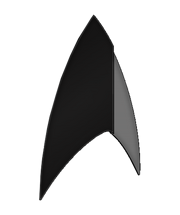This page will call all the needed FA blurb templates, so the uncreated ones will populate on the wanted templates page. For discussion on this template, use Template talk:Featured article.
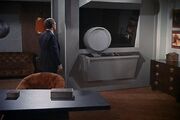
The Beta 5 computer in Seven's office
The Beta 5 computer was a sophisticated computer built by unknown aliens from a hidden planet located more than 1,000 light years from Earth. It was installed in 1968 at 811 East 68th Street, Apartment 12-B in New York City, which was occupied by pseudo-secret agent Gary Seven.
As a highly capable device, the Beta 5 was able to make analytical decisions due to its extremely advanced artificial intelligence. This artificial intelligence was supplemented with a snobbish, feminine personality.
The Beta 5 contained a vast database of knowledge on other planets and the history of Earth. It had the ability to check news broadcasts from across the globe, as well as intercept and decode government messages thanks to its exceiver circuits. The Beta 5 computer was also linked to a transporter chamber, located in an apparent walk-in vault, which could transport individuals simply by passing through the entranceway. Also built in was a materialization niche on the right hand side of its console that could be used for such purposes as producing false identification.
When not in use, the Beta 5 computer was hidden behind the bookcase in Gary Seven's office. The Beta 5 could then be accessed through a scanner, which resembled a green cube, located on Seven's desk. While active, the cube glowed brightly and then dimmed when waiting for further input. This interface device, however, was limited to only voice command input. For finer, manual control of the Beta 5, it needed to be taken out of hidden mode and accessed directly.

Hugh
Hugh, formerly Third of Five, was a former Borg drone rescued by the USS Enterprise-D in 2368 in the Argolis Cluster. Critically injured at the time, Dr. Crusher brought him back to the Enterprise for treatment. While there, he began to make friends with Geordi La Forge, who named him "Hugh" (a mispronunciation of the word "you").
When Hugh met Jean-Luc Picard, who was wary of having Hugh on board the ship, Hugh recognized him as Locutus, and informed him that he had learned that resistance was not futile, stating that he (and Hugh used the word I, his second use of a singular pronoun) would not assist in the assimilation of La Forge. Picard was stunned that a Borg drone would say such things, and Hugh was returned to where he was found to rejoin the Borg Collective.
This new sense of individuality proved deadly to the Collective, and his cube quickly fell into disarray and disconnected from the hive mind and drifted in space until 2370 when it was discovered by Lore. Lore assumed leadership over the group of drones, allowing them to remain as individuals, but ran tests on them, leaving them many with injuries. Hugh realized that Lore was a poor leader and led a rebellion against him.
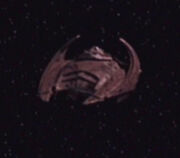
The Vahklas
The Vahklas was a Vulcan civilian transport commanded by Tavin, the leader of its crew of V'tosh ka'tur. The vessel used a Vulcan frequency to hail other ships and was capable of visual communication. The Vahklas left the planet Vulcan in approximately 2143.
Although the crew of the Vahklas disagreed with the common interpretation of Surak's teachings, an ornament resembling the Vulcan philosopher was displayed in a room aboard the transport ship.
In 2151, the Vahklas encountered the United Earth starship Enterprise, charting the nearby Arachnid Nebula, far from the planet Vulcan. Captain Jonathan Archer, commanding officer of Enterprise, commented that he had never seen a Vulcan ship like the Vahklas before. Sub-Commander T'Pol revealed that the Vulcans had not used the class of ship the Vahklas belonged to for a long time.
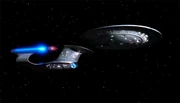
Saucer separation on a Galaxy-class starship
Saucer separation was an emergency maneuver performed on some Federation starships involving the complete disconnection of the primary hull and the secondary hull. During the 23rd century, separation was a one-time only event used only in a catastrophic emergency; the two sections could not reconnect easily following a separation.
In the 24th century, some starship classes were designed to routinely separate into one or more components. The procedure itself became more common and tactical, as well as emergency, uses became standard procedure. By this period, separation technology had advanced sufficiently to be performed at warp speeds. The procedure was extremely risky, with no margin for error; partially due to this, a high-warp separation was never attempted prior to 2364.
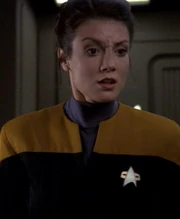
Tal Celes
Tal Celes was a Bajoran Starfleet crewman who served aboard the Federation starship USS Voyager. By 2376, Celes was a grade three sensor analyst assigned to Voyager's astrometrics department under Seven of Nine, the department's head.
Celes especially had difficulty with sensor data analysis. As a sensor analyst, her work had to be constantly double-checked much to Seven of Nine's immense irritation. Often, Celes had to call upon her closest friend on Voyager, crewman William Telfer, to help her with the analyses.
Captain Janeway took Celes, Telfer, and Mortimer Harren on a survey mission on the Delta Flyer, hoping to inspire them to better performance. Celes was nervous, especially toward Janeway. When the Delta Flyer was damaged during the mission, Celes suggested that the damaged piece be beamed aboard to try to determine the cause of the impact by scanning it for a quantum signature. The idea proved fruitless in the end, but Celes redeemed herself when she refused to abandon Janeway when a swarm of dark matter lifeforms advanced on the Flyer.
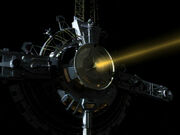
The wormhole relay station in action
The wormhole relay station was a subspace relay station that allowed communications from the Alpha Quadrant to pass through the Bajoran wormhole into the Gamma Quadrant between stardates 48543.2 and 50564.2.
Although communications through the wormhole were possible, it was unreliable and required the wormhole to be open while the transmissions occurred. Some attempts were made in 2370 to produce a reliable communications network that traversed the wormhole, but due to the wormhole's high interference, which consisted of unstable subspace carrier waves and high phase variances, the signal was not strong enough to pass through. Subspace communications that bypassed the wormhole could take over twenty years to reach the Gamma Quadrant.
The disastrous First Contact between the Dominion and the Federation created a growing need to have a reliable communications conduit to the Gamma Quadrant so that Dominion activity could be monitored.
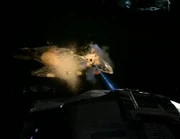
Jem'Hadar attack ships destroy the Koranak
The Battle of the Omarion Nebula was the first major armed engagement between forces of the Alpha and Beta Quadrants and the Dominion, as well as the only large-scale engagement to take place in the Gamma Quadrant. In the battle, a combined Obsidian Order and Tal Shiar fleet attempted to launch a preemptive strike on the Founders' homeworld in the Omarion Nebula, only to be ambushed and completely destroyed by the Jem'Hadar.
By any measure the Battle of the Omarion Nebula was a catastrophe for the Romulan and Cardassian forces resulting in destruction not seen since the Battle of Wolf 359; the Tal Shiar suffered a severe setback from which it would not recover from for some time, and the Obsidian Order ceased to exist altogether. The Founders had identified both organizations as a definite threat due to their efficient and ruthless natures, and had exploited Tain's plan in order to wipe out both of them in a single stroke. Their victory had been so overwhelming that the Dominion had essentially eliminated two of the major powers in the Alpha and Beta Quadrants from challenging them in the short-term; after their losses neither the Cardassians nor the Romulans would be very willing to wage war against the Dominion.

Kirk points out the blurry distortion of a cloaked Bird-of-Prey
A cloaking device was a form of stealth technology that uses selective bending of light to render a starship or other object completely invisible to the electromagnetic spectrum and most sensors. Cloaking technology was encountered in varying forms over the centuries.
One of Starfleet's earliest encounters with cloaking technology was in 2151, when the Suliban Cabal used a cloak to covertly approach Enterprise NX-01 and kidnap the Klingon Klaang from the ship's sickbay.
By the 23rd century, practical invisibility was considered only theoretically possible as the amount of power required would be enormous. In 2266, the USS Enterprise encountered a Romulan Bird-of-Prey that used a cloaking device to cross the Romulan Neutral Zone and wipe out several Earth Outpost Stations.
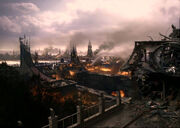
Cardassia lies in ruins
The Battle of Cardassia was the final battle of the Dominion War, fought in late 2375. The Federation Alliance, the forces of the United Federation of Planets, the Klingon Empire, and the Romulan Star Empire, launched an invasion of the Dominion-held Cardassian Union, with the goal of capturing the Dominion's capital on Cardassia Prime. The battle would ultimately lead to the Dominion's unconditional surrender of all forces in the Alpha Quadrant.
The events of the battle must also be considered alongside concurrent events on Cardassia Prime in the final stages of the Cardassian Rebellion, led by Legate Damar. The sabotage committed by the Cardassian insurgents played an important role in disrupting Dominion communications and support behind the front lines, and ultimately led to the Cardassian military switching sides. Before the battle was over, however, more than 800 million Cardassian civilians would be killed by Dominion genocide, leaving the once-proud capital planet in ruins.
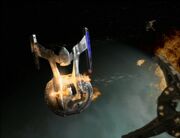
Cardassian orbital weapons platforms open fire on an Akira-class starship
The First Battle of Chin'toka was the first offensive launched by the Federation Alliance into territory held by the Dominion during the Dominion War. The battle, fought in late 2374, was a tactical and psychological victory for the allies, but failed to lead to a general invasion of Cardassian space. The heavy losses sustained in the battle forced the Allies to remain bottled up in the system so they were not able to advance any further, and as a result were easily contained by the Dominion. The system remained under almost constant attack until it was re-taken following the Dominion's alliance with the Breen.
Apart from the short and successful campaign to retake starbase Deep Space 9 during Operation Return about eight months previously, the Federation and Klingon Empire was fighting a wholly defensive war. Key planets, including Betazed, Coridan, and Benzar, had all fallen to the Jem'Hadar, while the Federation core worlds of Vulcan, Alpha Centauri, and Earth were coming into range of the Dominion war machine.
However, with the sudden entry of the Romulan Star Empire into the war, the allies had enough combined firepower to launch a full offensive on Dominion-held territory. Starfleet Command, in conjunction with the Klingon and Romulan high commands, agreed that the war could be won only by taking the war into enemy territory.
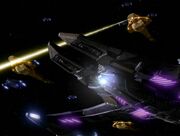
The Dominion War begins
The Second Battle of Deep Space 9 was the opening battle of the Dominion War, in which the combined forces of the Dominion and the Cardassian Union, led by Gul Dukat, launched an assault on the Federation-held starbase Deep Space 9. Although the station was captured by the Dominion, the battle was a strategic victory for the Federation because they successfully mined the Bajoran wormhole, preventing the Dominion from sending reinforcements to join the battle from the Gamma Quadrant. Also, the commitment of forces necessary to attack the station enabled a joint Federation-Klingon task force to destroy vital Dominion shipyards.
Following their annexation of the Cardassian Union around stardate 50560, the Dominion began fortifying their foothold in the Alpha Quadrant with weekly convoys of warships and troops through the wormhole. As time went on, Cardassian space became a veritable fortress, teeming with Jem'Hadar soldiers and their Vorta overseers.
Although a technical state of war did not exist, and neither side had fully committed to immediate combat, numerous skirmishes took place along the border during this period. Aside from the Dominion's attempt to destroy the Bajoran system using a trilithium bomb, the Jem'Hadar and the Cardassians attacked and destroyed numerous Federation and Klingon patrol ships in a sustained campaign across the border sectors. Casualties of these attacks included the USS Tian An Men and the IKS B'Moth.

The Xindi weapon is launched
The Xindi weapon was a massive, mobile particle beam weapon designed to destroy entire planets. There were actually three weapons built while the design was refined.
The weapons were built by the five Xindi species in cooperation, at the instigation of the Sphere-Builders, who had informed the Xindi that Humans would be responsible for the destruction of the future Xindi homeworld in the 26th century. The weapon's primary goal was the destruction of Earth.
Certain steps were taken to prevent any one species from controlling the weapon. The final version required activation codes from at least three of the five species in order to function. However, it could be fired instantly if all five codes were used. It could not be armed while the propulsion system was online.
The weapon was designed primarily by Degra, a Xindi-Primate scientist and member of the Xindi Council, and constructed by the Aquatics. Most of the weapon's components were built by the Xindi, but at least one component came from the year 2573, supplied to the Xindi by the Sphere-Builders. Another key component of the weapon was the mineral kemocite, which was provided by Gralik Durr's refining facility.
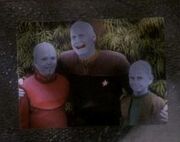
The Brott family
The Bolians were a humanoid species who were native to the Federation planet Bolarus IX.
Bolians were distinctively known for a bifurcating (cartilaginous) ridge running vertically along the center of the head and face, and partway down the chest. Skin color ranged from light green-blue to blue-gray to vivid blue and was occasionally accented with dark blue bands on the head.
Bolian males were completely bald, were on average as tall as the average Human male, and were not known for their physical prowess. Male Bolians have been known to wear toupées on occasion. Bolian females were predominantly bald. However, there were the occasional few who had hair.
In addition to the ridge on their heads, they were also noted for having cartilaginous lining on their tongues that allowed them to consume foods not normally palatable by other races, including strong acids. One such example of traditional Bolian cuisine was the consumption of meat that had been allowed to partially decay.

Thot Pran, representative of the Breen Confederacy (2375)
The Breen were a reclusive, powerful, and warlike humanoid race, native to the planet Breen in the Alpha Quadrant. Shrouded in mystery, the Breen were also one of the most underestimated races inhabiting that quadrant of space.
Historically, the Klingons were among the first to discover that the Breen didn't tolerate incursions into their space. During the Klingon Second Empire, Chancellor Mow'ga ordered an entire fleet of Klingon warships to invade and conquer the Breen homeworld. The fleet never returned and was never heard from again.
Breen privateers during the 24th century often conducted indiscriminate raids against other Alpha Quadrant species. This included the Breen attack and capture of a Cardassian transport, the Ravinok, in 2366. The survivors of that attack were used for slave labor in Breen-operated dilithium mines on Dozaria.
Even by the 24th century, though, much was still unknown about the Breen and their government, known as the Breen Confederacy. The Federation had limited knowledge of the Breen, however, and was aware of Breen outposts located in Sector 97 in 2368. That same year, Starfleet feared the Breen might have attacked the science vessel SS Vico there.
Section 31 was a clandestine organization which claimed to protect the security interests of United Earth, and later the United Federation of Planets. Officially-nonexistent, the organization's title came from the original Starfleet Charter, Article 14, Section 31 of which allowed for extraordinary measures to be taken in times of extreme threat. Section 31 was somewhat comparable to the Romulan Tal Shiar or Cardassian Obsidian Order.
Section 31's agents claimed the organization had existed since the beginning of Starfleet in the 22nd century. In the mid-23rd century, they were mentioned in rumors and considered a critical division of Starfleet Intelligence. Section 31 even had their own black Starfleet insignia at this time. By the late-24th century, Section 31's very existence was a deeply buried secret, known only to a handful of people beyond its own membership and believed to be a rogue organization not considered part of the Federation. It was autonomous, having operated for over two centuries with little to no oversight or accountability, free to kill or remove those it deemed a threat to Federation interests at its own discretion with well-placed agents in nearly every level of both the civilian Federation government and Starfleet's command structure, allowing it to carry out operations without risk of being publicly exposed.
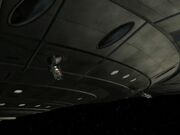
Phase cannons being deployed
A phase cannon was a phase-modulated energy weapon, a type of particle weapon which served as a successor to plasma cannons and as a precursor to the phaser of the 23rd and 24th centuries. The prototypes of ship-mounted phase cannons were first introduced by Starfleet in the mid-22nd century, designed as the primary defense of NX-class starships. The first NX-class vessel to test and actively use phase cannons in battle was the NX-01 Enterprise.
Designed as a starship-based version of the hand-held phase-pistol, the phase cannon was rated for a maximum power output of five hundred gigajoules. The cannons were mounted on retractable turrets which extended from the ship's hull when deployed and rotated as they were being targeted. Like phase-pistols, they emitted a concentrated beam of energy that could be set at different yields. The phase cannon assembly was equipped with multiphasic emitters and had a maximum yield of eighty gigajoules. Aboard an NX-class vessel, the assembly was located on F Deck and could be accessed through a hatch near the torpedo room.
The cannons were first installed aboard Enterprise in 2151. They were generally more powerful than spatial torpedoes and were therefore more effective in a firefight. Although they were not always powerful enough to penetrate the defenses of enemy vessels, they proved to be an integral part of the ship's defenses throughout the early 2150s.

The Bajoran capital city in shambles after the Cardassian withdrawal in 2369
The Occupation of Bajor, usually referred to simply as the Occupation, was a period from about 2319 to 2369 during which Bajor was under the control of the Cardassian Union. During the Occupation, the Cardassians perpetrated a coordinated scheme of strip-mining, forced labor, and genocide across the planet. Their brutality led to the deaths of more than ten million Bajorans. This eventually gave rise to the fierce Bajoran Resistance, which used guerrilla and terror tactics. The Cardassians eventually withdrew due to political pressure from the United Federation of Planets, as well as the Resistance's constant attacks.
Prior to the Occupation, the Bajorans were a peaceful people whose art and architecture were well-known and admired throughout the galaxy. The Cardassians, by contrast, were a militaristic and often hostile people who had conquered numerous planets in the name of survival. The two peoples nonetheless managed to coexist peacefully for some time; however, the Cardassians coveted Bajor's rich natural resources and saw the Bajoran people as inferior. Cardassia became increasingly hostile as time went on, maintaining a military presence on the planet for ten years before forcibly annexing it in 2328. This travesty caused little galactic outcry, as most major powers were unaware of or unconcerned with Bajor's plight. Even the Federation was unable to interfere, as the Prime Directive forbade it; the occupation was considered an internal matter between Cardassia and a subject race.
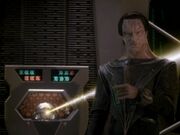
Gul Dukat stands casually in Ops as the self-destruct counts down
The counter-insurgency program was a security measure designed for a hypothetical revolt by Bajoran laborers aboard Terok Nor.
It was installed by its commanding officer, then-Gul Dukat during the Occupation of Bajor because the Bajorans far outnumbered their Cardassian overseers. The program was designed so Dukat and his fellow Cardassian officers could interact with and control it, but if necessary, it could run independently. To ensure smooth operation, the program had several levels of severity to allow it to deal with a variety of scenarios, the focus being a revolt by laborers in ore processing. Naturally, Dukat omitted mention of the program's existence when control of what was now called Deep Space 9 passed to Benjamin Sisko in 2369.
If the workers escaped or the insurgency spread and resulted in an escape from ore processing, the program was set to take control of the station. Force fields would secure sensitive areas of the station's computer circuitry, Ops and the security office, with similar force fields blocking access to virtually every major doorway on the station.
The program was discovered by Miles O'Brien, and Jake Sisko in 2371 while investigating the possibility of turning the ore-processing area into a deuterium refinery. Lack of knowledge about the program caused the crew to activate the program's higher levels once the station-wide program took effect...
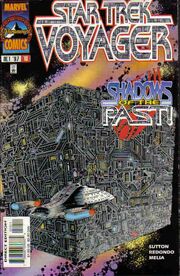
"Ghosts" - Marvel VOY issue #10
"Ghosts": Shadows of the past! is a Star Trek: Voyager comic book published by Marvel Comics in October 1997 in which Voyager encounters a temporal rift, showing them the Battle of Wolf 359.
En route to the Alpha Quadrant, the USS Voyager suddenly encounters an all-too-familiar sight: on-screen, they witness the carnage of the Battle of Wolf 359. Tuvok suggests it may be some elaborate deception, noting that the battle took place six years prior. Ensign Kim however, informs Captain Janeway that he detects high concentrations of chronitons, suggesting time travel is involved.
As Voyager backs away, the images of the battle disappear, but in their place, the crew detects several Federation escape pods. Tuvok again recommends caution, but Ensign Kim detects life signs on board, as well as a genuine Federation distress signal.
Further scans show the pods to be survivors of the USS Saratoga, the USS Roosevelt, and the USS Melbourne, the flagship of Admiral Hanson. Voyager is unable to communicate with the pods, so Captain Janeway orders the survivors to be beamed to sickbay. Tuvok informs her the transporter would be unsafe, due to the chroniton radiation, so the tractor beam is used to tow the pods into the shuttlebay. Janeway is still understandably apprehensive about the situation, so she orders security to meet her there to find out who or what is inside...
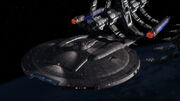
Enterprise is launched
"Broken Bow": A young Jonathan Archer paints a model of his father's spacecraft in San Francisco and recites a quote from a speech by Zefram Cochrane. Jonathan curiously asks about his father's ship, wondering if it will be bigger than Ambassador Soval's ship. Although Henry Archer does not fully understand the reasons behind the Vulcans' constraint of Human space flight, he believes that there must be an explanation.
Thirty years later, the wreckage of a crashed Klingon K'toch-class scoutship lies in a cornfield in Broken Bow, Oklahoma. Klaang, the Klingon pilot of the craft, desperately flees from two pursuing aliens. The commotion attracts the attention of a farmer. Although Klaang eventually manages to kill the aliens, he is shot by Moore's plasma rifle.
Aboard an inspection pod, Jonathan Archer, now a captain in Starfleet, and Commander Charles Tucker inspect the prototype NX-class starship Enterprise in a spacedock orbiting Earth. After being called back to Starfleet Medical, Archer attends a meeting where the fate of Klaang is discussed with several Vulcan dignitaries. It is decided that Enterprise will launch ahead of schedule on a mission to return Klaang to the Klingons' homeworld, Qo'noS.
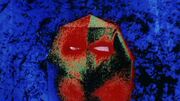
Loskene, a Tholian in 2268
The Tholians were an extremely xenophobic, non-humanoid race with a propensity for precision, native to the Alpha Quadrant.
In 2152 the Tholians made an unusual move and traveled far beyond their territory and actively sought to possess a 31st century time-travel pod discovered by the United Earth starship Enterprise. Four Tholian starships intercepted and disabled the Vulcan cruiser Tal'Kir, while it waited to rendezvous with Enterprise. They would, in turn, attack and defeat the Suliban fleet that was in pursuit of the arriving Terran vessel. They would then successfully remove the pod from Enterprise's possession, only to have the pod return to its proper time moments later.
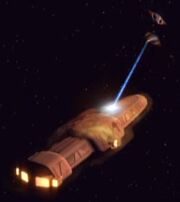
Dreadnought attacks the Rakosan defensive fleet
The Cardassian ATR-4107 was an automated weapon capable of unleashing massive destruction. Although officially referred to as a missile, it can also be considered a completely autonomous warship in its own right. It was a warp-capable vessel carrying 1,000 kilograms of matter and 1,000 kilograms of antimatter – enough to destroy a small moon. The missile also carried a large cache of conventional weaponry, including disruptors, prototype quantum torpedoes, a thoron shock emitter and a plasma wave. On board was a sophisticated computer system that could predict and counter hostile actions.
In late 2370, the Cardassians deployed the missile to destroy a Maquis munitions base. However, the missile failed to detonate upon reaching its target. Maquis member B'Elanna Torres reprogrammed its computer and upgrading its systems to work for the Maquis, and eventually nicknamed it Dreadnought.
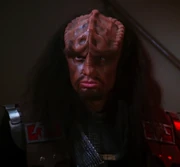
Duras, son of Ja'rod
Duras, son of Ja'rod was a powerful and ambitious political figure in the Klingon Empire during the late 24th century. He and his family became notorious for dishonorable and sometimes treasonous tactics in order to accumulate and maintain power, which culminated in the Klingon Civil War of 2367-2368.
Duras was a member of the Klingon High Council when records were discovered implicating Duras' father as having betrayed the Khitomer colony to the Romulan Star Empire. With the help of Chancellor K'mpec, the blame was shifted to Mogh, one of Duras' long-standing enemies, and the father of Worf.
The death of K'mpec led to a struggle between Gowron and Duras for the position of Chancellor. During this struggle, Duras killed Ambassador K'Ehleyr. Her body was discovered by Worf, who beamed over to the IKS Vorn and killed Duras in a duel under Klingon law.

Detail of an Issued Design Patent
Design patents are a type of patent issued under United States of America law. (Other locations have similar protections but they are called different things.) The patent is granted based on the unique appearance or concept of an item rather than its "usefulness". Design patents typically are sought for items where the appearance is as - or more - important than the underlying craftsmanship itself. So, things like jewelry, toys, furniture, car parts, etc. are frequently granted design patents.
Design patents have a life in the US of fourteen years from the date of issuance. Their main usefulness is as a supplement to copyright protections. Whereas someone claiming a copyright in a work can prevent actual copies being made, a design patent can more easily be used to prevent the unauthorized creation of similar items which are not actually copies. Neither protection is absolute, but some counsel believe that having both is important where even the hint of similar design is a threat to the value of the original design.
From 1978 through 1987, Paramount Pictures sought and obtained various design patents for Star Trek designs. There seem to have been no other filings after 1987, and Paramount's legal department instead probably feels comfortable with existing copyright protections.
In each instance of a design patent at least one "inventor" has to be listed. The inventor can never be the corporation, it has to be an individual or individuals. It is sometimes interesting to see who gets credit for what on the official documents.
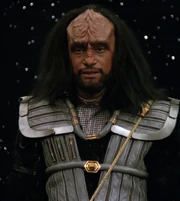
Kurn in 2366
Kurn was a Klingon warrior, the son of Mogh and younger brother to Worf. His true family name was kept secret until 2366, when Mogh was accused of being a traitor. Kurn later supported Gowron during the Klingon Civil War, and, afterward, gained a seat on the Klingon High Council. However, he fell from grace when Worf refused to support the Klingon invasion of Cardassia. To regain his honor, his memory was wiped and he assumed a new identity.
Kurn was not a year old when his father Mogh left Qo'noS for Khitomer with his wife and older son Worf. However, because Kurn was so young, he was left in the care of Lorgh, a family friend. After his family was presumed killed at the Khitomer Massacre, Lorgh accepted Kurn as his own son. Kurn did not know his true family until he reached the Age of Ascension. Kurn eventually joined the Klingon Defense Forces and rose to the rank of commander.

An Orion slave girl
The Orions were a warp-capable humanoid species from the Alpha Quadrant. This species originated from the planet Orion in the Orion system.
Orions were known for their distinctive green or blue skin. Orion males were typically bald and, on average, taller and more muscular than the average Human male. Orion females were very animalistic in nature, known for their extreme carnal appetites and their innate skill of seduction. A Human male could rarely resist the alluring dance of the Orion slave girl.
In Orion society, the males were slaves to the females. As a means of deceiving other species, the Orions maintained the facade that the females were the slaves. This was commonly done by selling Orion females on the Orion slave market.
Orion once harbored a highly advanced civilization whose history had drawn great interest from Federation historians and archaeologists alike. During the mid-23rd century, noted Federation archaeologist Doctor Roger Korby translated medical records from the Orion ruins that helped revolutionize modern immunization techniques and became required reading at Starfleet Academy. In 2269, through the assistance of the Guardian of Forever, Starfleet officers Captain James T. Kirk, Commander Spock, and historian Lieutenant Erickson traveled to the dawn of Orion's civilization to view the planet's history unfolding, firsthand.

Cardassia Prime in 2375
Cardassian history is perhaps one of the most brutal histories of the species inhabiting the Alpha Quadrant. Originally, the Cardassian homeworld was that of a deeply spiritual and artistic people, which soon fell into decay when famine and plague struck their civilization. Over the years, Cardassian society evolved to adopt a philosophy that sacrificed their individual freedoms for the greater good of the state and their society. For over five centuries, the iron fisted Cardassian military sought to solve Cardassia's problems through the conquest of numerous worlds and species throughout the galaxy, leading to an era of expansion and conflict. This ultimately left Cardassian civilization in ruins once again after suffering the staggering losses of two major wars.
The ancient Hebitians were a spiritual and peaceful civilization which thrived on Cardassia Prime centuries prior to the formation of the Cardassian Union. The Hebitian burial vaults were said to be magnificent and filled with many jeweled artifacts made of jevonite. Due to the planet's scarcity in natural resources, the impoverished society suffered from famine and disease, leading to millions of deaths. The frail population then turned to a militaristic ideology thus ending the Hebitian way of life.
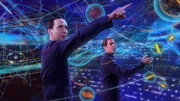
Archer and Daniels in the Temporal Observatory
The Temporal Cold War was a conflict fought between several time traveling factions, each from different points in time, and each attempting to manipulate history for its own benefit, in violation of the Temporal Accords. Each of these factions opposed one another in their attempts to gain dominance over the timestream, and often used proxy powers to carry out their missions. They were opposed by a group of temporal agents from the 31st century, who attempted to protect the integrity of the timeline.
Starfleet first became aware of the Temporal Cold War in April of 2151, when a Klingon courier named Klaang crashed in Broken Bow, Oklahoma. Spurred by a desire for Humanity to display an ability to manage its own affairs, Enterprise captain Jonathan Archer elected to push up the launch of Enterprise by three weeks in order to return Klaang to his people. During the course of this mission, Enterprise's crew encountered a group of Suliban on Rigel X, who were actively opposing the Suliban Cabal, a group which was taking orders from a faction in the 28th century. Through Sarin, one of the leaders of the resistance group, Archer learned of the Temporal Cold War and of the Cabal's attempts to destabilize the Klingon Empire. When Enterprise returned Klaang to Qo'noS, the Klingon High Council was made aware that the Cabal had been staging attacks within the Empire, trying to make it appear as if one house were attacking another.

Two female Cardassians with a male
Cardassians were a humanoid species from the Alpha Quadrant. They were native to the planet Cardassia Prime, capital world of the Cardassian Union. Known throughout the Alpha Quadrant for their ruthlessness, the Cardassians became one of the greatest enemies of the Federation and Klingon Empire when they joined the Dominion in 2373. Their xenophobic attitude towards other species was well established throughout the quadrant after the Setlik III massacre during the Cardassian Wars, as well as when their atrocities from the Occupation of Bajor were revealed after their withdrawal in 2369.
In its ancient history, before Cardassia became a military dictatorship, the Cardassian society was known as the Hebitians. It was home to fine art and beautiful architecture. Once the Hebitian civilization fell into decay from lack of natural resources, millions of Cardassians were starving and the planet was subjected to utter anarchy. Though the Hebitian society and way of life eventually became extinct, the remaining Cardassians turned to the military to solve their problems. This began the Cardassian policy of expansion into the galaxy, to provide the much-needed natural resources to sustain its population.
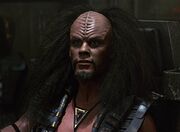
Klaa
Klaa was a young upstart Klingon Bird-of-Prey captain on a personal mission to make a name for himself in the Klingon Empire in 2287.
Tired of shooting space garbage, Klaa thirsted for a target that would fight back.
After receiving a priority message from Qo'noS, Klaa learned of a situation on Nimbus III where the Klingon consul, General Korrd, had been taken hostage; along with the Terran and Romulan consuls. Klaa reasoned that the Federation would be sending a rescue ship of its own, so he set course for Nimbus III seeing this as an opportunity to engage a Federation ship.
Klaa soon discovered that the USS Enterprise-A, the ship commanded by James T. Kirk himself, a man he both respected and despised, was dispatched to Nimbus III. News of this further drove Klaa's thirst for battle, with Vixis, his second-in-command, telling the crew that if Klaa could defeat Kirk, he would be the greatest warrior in the galaxy.
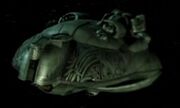
Harrad-Sar's barge
Harrad-Sar's barge was a design of Orion starship that was piloted by Harrad-Sar.
Harrad-Sar's barge was equipped with powerful weapon systems. It also had scanners that could detect mineral deposits below the surface of a planet, although their results could sometimes be incomplete. The ship was capable of receiving and transmitting visual communications between itself and another vessel. It had an advanced propulsion system and was capable of extremely erratic and swift movements. If its engines were damaged, the craft could still use its on-board impulse drive. The vessel was also able to dock with other ships and was capable of towing spacecraft with the use of a towing cable, a tactic that was often utilized to commandeer enemy vessels.
At least two rooms were contained within the craft. The vessel's bridge had a padded, black chair directly facing a visual communications device that was slightly to the side of a brilliant white light. Behind the chair, three tiny lights hung from the ceiling at different angles and helped to illuminate the room. The lights were positioned between the padded chair and a wall decorated with an intricate Orion design. The wall itself was brown but its Orion design incorporated little green lights.
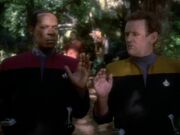
Sisko and O'Brien realize they are not alone
"Paradise" is the fifteenth episode of the second season of Star Trek: Deep Space Nine.
- Station log: Stardate 47573.1. To respond to questions about setting up colonies near the wormhole, Chief O'Brien and I have set out to survey nearby star systems.
Sisko and O'Brien are in the middle of a discussion about the possibility of Jake Sisko apprenticing under the Chief. As they talk, they come upon an M-class planet which would be a perfect place to build a colony. However, there is already an uncharted Human colony on the planet. The colony does not respond to hails, likely due to the presence of a low-level duonetic field. They decide to beam down and say hello the old-fashioned way.
The moment Sisko and O'Brien materialize on the planet's surface, their tricorders cease functioning; not even the diagnostics subroutine will work. Sisko attempts to contact the runabout, the Rio Grande, but his comm badge, as well as their phasers, appear to be nonfunctional as well. O'Brien suspects the suppression of their devices' EM activity may have something to do with the duonetic field, although he is not sure what. Before they can investigate further, a voice from behind orders them not to move and to put their hands up...
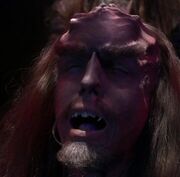
A Klingon's forehead ridges dissolving
"Affliction" is the fifteenth episode of the fourth season of Star Trek: Enterprise and the first episode of a two episode arc.
A Klingon scientist works in a laboratory, watched by a Klingon general and a guard. A representation of a DNA helix is displayed behind the scientist. A door opens and a Klingon prisoner is led into the laboratory by two soldiers of the Empire. In Klingonese, the prisoner claims that his death sentence was commuted and demands to speak with the magistrate who presided over his trial. The Klingon soldiers strap him to a chair and hangs a vial of green liquid above his head, which the scientist injects him with. Confused, the prisoner wails as his cranial ridges ripple and begin to dissolve.
Returning to Earth, Enterprise finds the NX-class starship Columbia in an orbital drydock facility, undergoing final preparations for her maiden voyage.
Doctor Phlox and Ensign Sato exit Madame Chang's restaurant in San Francisco. Suddenly, two shadowy figures step out of an alleyway and order Phlox to accompany them. When the Denobulan voices his confusion, one of the men aims a disruptor at the doctor. Hoshi uses her knowledge of aikido against the men but another hooded assailant appears behind her and knocks her to the ground. The doctor is restrained and carried away as Hoshi lies on the ground, barely conscious. As her eyes flutter, the linguist hears one of the men say something in an alien language before disappearing...
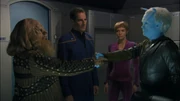
Commander Shran and Ambassador Gral call a truce
"United" – Aboard the prototype Romulan drone-ship, Commander Tucker and Lieutenant Reed struggle to regain their footing as the ship is violently shaken. On Romulus, the drone-ship's pilot works on erratically maneuvering the vessel. Ordering the pilot to stabilize the ship, in preparation for its imminent attack, Nijil reports that he is activating the vessel's multispectral emitters – its holographic "skin". In the dark vacuum of space, the drone-ship swoops down and destroys a Rigelian scout ship, disguised as Enterprise.
Gathered around the situation table on the bridge of Enterprise, Captain Archer tells Ensign Mayweather and Commander T'Pol that the visual record which was sent by the Rigelian ship showed Enterprise firing at the vessel. T'Pol tells him that she has discovered a method to detect the stealth vessel's warp signature, while Travis has designed a sensor grid which will extend Enterprise's range. Although the grid will require 128 vessels, it should prove to be an effective way to find the drone-ship.
In sickbay, Shran jokes with Talas as the doctor is treating her wound. Although Talas was only grazed, the phase-pistol that Naarg shot her with was set to kill. When Talas asks, Shran promises not to let her die unavenged. Phlox enters and apologetically asks Shran to leave. Before he does so, Archer enters and offers him a proposal. Shran doesn't listen to the captain's suggestion, wanting only to kill the Tellarites. As he leaves, Archer realizes that uniting the Andorians, Tellarites, Vulcans and Humans will prove harder than he thought.
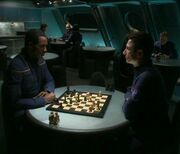
Controlled by aliens, Reed and Mayweather play chess
"Observer Effect" is the eleventh episode of the fourth season of Star Trek: Enterprise.
As Enterprise orbits a nearby planet, it seems that Travis Mayweather and Malcolm Reed are playing chess in the mess hall. In reality, however, they are under the control of two noncorporeal aliens. They talk about the game in technical terms and discuss the Humans they are observing on Enterprise. When "Mayweather" asks "Reed" how the Humans will react to what they find on the planet's surface, "Reed" answers that, in his experience, at least one member of every species that has come here has died as a result. He also mentions that some species have lost an entire ship's crew.
In a shuttlepod, Commander Trip Tucker and Ensign Hoshi Sato return to Enterprise from the M-class planet, where they were excavating a Klingon garbage site. Tucker hails the starship and speaks with Captain Archer. He tells the captain that their search was unsuccessful. All they found was an old power cell, some empty ration packs and a latrine. Suddenly, Tucker starts coughing uncontrollably and eventually collapses. Sato informs the senior officers of Tucker's condition. "Mayweather" and "Reed" watch as Archer asks Sato to pilot the shuttlepod into the launch bay and requests that T'Pol notify Doctor Phlox to be ready...
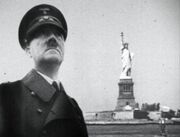
Adolf Hitler in a newsreel off of Liberty island
"Storm Front, Part II" is the second episode of the fourth season of Star Trek: Enterprise.
A newsreel segment from 1944 shows Adolf Hitler as he visits a conquered New York City, getting a hero's parade through Times Square, touring the Statue of Liberty and the Empire State Building, and receiving the keys to the city. The newsreel's commentator reports Hitler has pledged to eradicate the "financial profiteers" that have plagued America's economy since the 1920s. It may be Earth, 1944, but the timeline has been drastically changed in favor of the Nazis that were destined to lose the planet's Second World War.
In the swastika-draped White House, a German general continues to discuss the Nazis' occupation of America with Vosk, a 29th century Na'kuhl time traveler responsible for the corruption of the timeline. The general fears an imminent counter-offensive from the American resistance, a rumor that he argues is now fact. The general raises his voice arguing that the Na'kuhl have promised to defend Germany yet they continually work to stall progress. Questioning Vosk's loyalty, the general tells the Na'kuhl officer that his people will not receive additional supplies until they have fulfilled their part in the alliance. Vosk imagines the devastation that the Na'kuhl's weapons, such as plasma cannons, could cause if the American resistance managed to steal them. When the Nazi general argues that Vosk's statements are treasonous, the Na'kuhl officer grows tired of the Human and threatens the general's very existence in history...
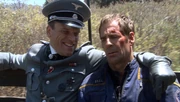
Archer as a prisoner-of-war on a German truck
"Storm Front" is the fourth season premiere of Star Trek: Enterprise and the first episode of a two episode arc.
Trip Tucker and Travis Mayweather are piloting a shuttlepod toward Starfleet Headquarters in San Francisco to discover why they have lost all communication with Earth since the destruction of the Xindi weapon. Their "First Contact" comes in the form of an attack from a small formation of aircraft. Tucker attempts to contact the planes, but they refuse to answer. Mayweather recognizes the aircraft as P-51 Mustangs, World War II-era aircraft. He explains to Tucker that he has seen the same design of plane before at air-shows. The aircraft seem to be breaking off, so Tucker looks for a landing area on the ground. However, the planes were simply making sure they wouldn't get hit by heavy anti-aircraft artillery being fired at the shuttlepod. When the shuttlepod's starboard engine is damaged, Tucker and Mayweather flee back to the orbiting Enterprise.
Captain Archer, having recovered from his wounds in a Nazi field hospital, is being transported as a prisoner-of-war in the back of a large truck. A Nazi officer belittles the American war effort, causing Archer to suspect that he is in Earth's past. However, the officer's swagger and manner of discussion lead Archer to suspect that he may be in an alternate timeline...
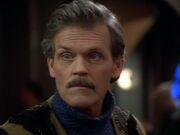
Raymond Boone, O'Brien's friend from the Rutledge
"Tribunal" is the 25th episode of the second season of Star Trek: Deep Space Nine.
Chief Miles O'Brien and his wife Keiko are scheduled to go on vacation, and as O'Brien hurries along the Promenade on his way to the runabout he nearly drops several PADDs he is carrying. A nearby Human moves to help with the load, but O'Brien reassures him he has it under control. As O'Brien walks away, the man seems to recognize his face but not his name. O'Brien realizes who he has just seen and turns back, recognizing Raymond Boone, one of his former colleagues from the Rutledge. Boone recognizes the name Miles O'Brien immediately and is glad to see him after so long.
Boone says he left Starfleet eight years ago and now resides on the Cardassian side of the Demilitarized Zone. He admits that the new Federation-Cardassian Treaty puts him and his fellow colonists in harm's way, but he says the Cardassians leave him alone since he mines ladarium. O'Brien is surprised and does not understand how Boone could live among the Cardassians after what happened in the Border Wars at the Setlik III massacre. While the incident convinced O'Brien to stay in Starfleet, Boone says it convinced him to leave. The two plan to meet the next time Boone is on the station, but Boone loses his friendly air once O'Brien is gone. Later, Boone enters his quarters carrying a data pad on which he recorded the exchange with O'Brien, and now he sorts through it to find the portion where O'Brien stated his name. "O'Brien! Miles O'Brien," it says...
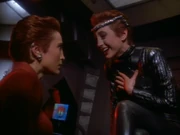
Major Kira and Intendant Kira
"Crossover" is the 23rd episode of the second season of Star Trek: Deep Space Nine.
- "Medical log, supplemental. Major Kira and I are returning home after opening the hospital on New Bajor, the first Bajoran colony in the Gamma Quadrant."
As Major Kira and Doctor Bashir make their way back to Deep Space 9, Kira asks Bashir to take control of the runabout USS Rio Grande, as she has a headache and would like to meditate. As their runabout drops out of warp, the warp field does not collapse properly and they are engulfed in a white flash upon entering the Bajoran wormhole. When they exit the wormhole in the Alpha Quadrant, they are shocked to see the station is gone, instead it is orbiting Bajor much as it did during the occupation. Before either of them can react, the runabout's sensors detect a Klingon Vor'cha-class attack cruiser moving towards them. Two Klingon officers beam aboard the runabout and are shocked to see Kira. Apologizing profusely, they offer to escort her back to the station; she simply nods, obviously confused.
Upon arriving at Terok Nor, the two Klingons confer with a Cardassian officer named Garak. Bashir and Kira board the station, where they are confused to see Garak and even more confused to see another Kira Nerys...
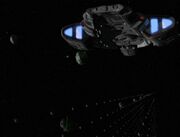
The Defiant deploying mines
"Call to Arms" is the 26th and final episode of the fifth season of Star Trek: Deep Space Nine.
Commander Sisko and Miles O'Brien move to one of the Promenade windows where a large crowd has gathered. O'Brien states that "maybe they're not coming", to which Sisko replies "that would be a nice surprise". Suddenly, the wormhole opens and several dozen Dominion starships enter the Alpha Quadrant on their way to Cardassian space. This is the fifth Dominion convoy to enter the Alpha Quadrant in as many weeks. Sisko predicts that an attack will occur soon.
Later, in the wardroom Sisko reveals that the Romulans have signed a non-aggression pact with the Dominion, joining the Tholians and the Miradorn who have already done so. The Bajorans are still debating the pact as they were also recently offered it, but Kira assures everyone that they will never sign it or any form of agreement with the Dominion. Sisko also reveals that Starfleet Command has decided no more Dominion ships can be allowed into the Alpha Quadrant. A minefield will be deployed at the mouth of the wormhole to stop the Dominion convoys. Odo comments that by doing so they could start a war, to which Sisko replies that "Maybe so. But one thing's for certain: we're losing the peace, which means a war could be our only hope..."
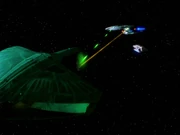
The Enterprise-D appears to be under attack from a Romulan warbird
"Timescape" - Captain Picard, Lt. Cmdrs Data and La Forge and Counselor Troi are on board a runabout on course for a rendezvous with the USS Enterprise-D. Data turns helm control of the runabout over to the computer and joins the others, who are sitting at a table finishing their lunch, discussing the conference they attended on the effects of deep space assignments.
Soon, the runabout arrives at the rendezvous coordinates but there is no sign of the Enterprise. La Forge reads a faint, possibly metallic, signature, however power levels from the signature are negligible and appear fragmented. The runabout makes its way to the source of the signal but the fragmentation effect increases and the runabout slows further to compensate. Looking through the cockpit window, the crewmembers' confusion turns to shock – the Enterprise and a Romulan Warbird are in the midst of a battle, but the disruptor fire from the Warbird is frozen in mid-blast and both ships appear suspended in time.
The three officers materialize on the bridge of the Enterprise and discover that the vessel has taken some damage. Three Romulans are present, all armed with disruptors. The officers investigate further: Data moves to the operations station, Troi approaches Commander Riker, who lies on the floor with a Romulan over him, and Picard checks the command center. None of the consoles function but the console at Ops shows a massive power surge in main engineering. Information from tactical indicates that security teams have been dispatched to transporter room three and sickbay.
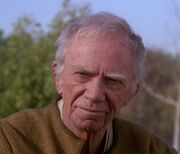
Mr. Boothby
Mr. Boothby was the curmudgeonly groundskeeper at Starfleet Academy in San Francisco on Earth. He was born in the mid to late 23rd century and has been working at Starfleet Academy since about 2321. He has seen a lot of promising young cadets come and go, often offering up helpful advice and kind words; among them such prominent Starfleet captains as Jean-Luc Picard, Kathryn Janeway, Richardson, and Lopez.
Boothby was disdainful of herbicides and other high-tech devices, and preferred to tend to the grounds by hand. After a big parrises squares win in 2324, it took Boothby three weeks to repair the grounds following the celebration. In 2368, Boothby claimed that he was cranky because he had been forced to replant the same flower bed several times.
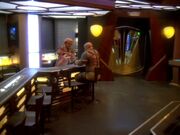
Quark's Bar, Grill, Gaming House and Holosuite Arcade
Quark's Bar, Grill, Gaming House and Holosuite Arcade was the multi-level, vibrant, and popular central attraction of Deep Space 9's Promenade, drawing crowds of travelers and station inhabitants with its offerings of drink, food, gossip, gaming, and fantasy fulfillment. The proprietor of the establishment was Quark, a Ferengi entrepreneur and sometimes petty criminal who was the eternal thorn in the side of the station's chief of security, Odo. Despite his dalliances on the wrong side of the law, Quark was a capable and amiable host, and the bar was usually one of the most popular places for recreation on the station.
Business in Quark's was conducted in gold-pressed latinum. The bar sometimes featured live music, and occasionally offered cut-price drinks during happy hour. According to a very small sign above the main entrance, the establishment was not responsible for the loss of any personal items.
In the aftermath of the Cardassian withdrawal, the Bajoran Provisional Government invited Starfleet to take over administration of the station. Desperately in need of a way to bind the station's remaining inhabitants together and transform it from a place of suffering and slavery into one of peace and prosperity, new station commander Benjamin Sisko persuaded Quark to stay and re-open the bar, effectively becoming a community leader. Quark's duly re-opened and soon filled the Promenade with the sound of laughter and music; the newly-christened "Deep Space 9" had found its heart.
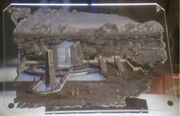
The painting of the ancient lost city of B'hala
"Rapture" is the tenth episode of the fifth season of Star Trek: Deep Space Nine.
In the wardroom on Deep Space 9, Captain Sisko, Major Kira, and Jadzia Dax admire a twenty-thousand-year-old painting of the lost Bajoran city of B'hala – the only known proof that the city ever existed. While Jadzia is surprised that the painting isn't a lot bigger, Kira and Sisko are in awe of the ancient artifact, which has been returned to the Bajorans by the Cardassian Government. Sisko points out a Bantaca spire in the painting, explaining that markings upon the spire describe the co-ordinates of the lost city; however, since two of the spire's sides cannot be seen, the city's exact position is difficult to decipher. He has the picture scanned into the computer so that he can study it, prompting Kira to recall a prophecy that only one who had been touched by the Prophets could find the ruins of B'hala.
In his office, Sisko looks at the computer scan of the painting and the markings on the spire. Adjourning to a holosuite, he produces a recreation of the spire, and has the computer overlay images of the markings from the painting, as he begins a quest to decode the co-ordinates. Later, he is interrupted by Quark, who comes into the holosuite to inform him that it is after 3 am. After dismissing Quark's offer of a visit to a pleasure maze, Sisko tries to save the program to a isolinear rod. As he works a console, however, there is an explosion and the captain is thrown to the floor, plasma energy crackling over his body. Shocked, Quark calls the infirmary...
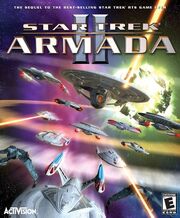
Cover of Star Trek: Armada II
Star Trek: Armada II is a real-time strategy game, published by Activision in 2001. The sequel to Star Trek: Armada, it featured improved three dimensional graphics as well as more classes of ships. It also added Species 8472 and the Cardassian Union as playable races.
- "The Federation stands on the precipice of another major conflict that threatens the fragile peace we have worked so hard to achieve. It's been six months since we successfully dealt with the threat of the Omega Particle. Tensions between the Cardassians and the Klingon Empire are on the rise, and we've just received word of a renewed Borg threat."
Following some complaints about the length of the Armada version, the single-player campaign was altered for this game; now only three races are involved, and each storyline is mostly independent of the others: the Federation must repel a Borg invasion via a new type of transwarp gate, taking the assault into the Delta Quadrant; the Klingons must deal with a resurgent Cardassian military, while the Borg, affected by events in the Federation campaign, must stave off an attack by Species 8472, before combining with the Federation to eliminate this galactic threat.
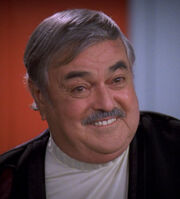
Montgomery Scott in 2369
"Relics" is the 129th episode of Star Trek: The Next Generation, the fourth episode of the show's sixth season. It originally aired during the week of 13 October 1992.
The USS Enterprise-D picks up a distress call from the USS Jenolan, a transport vessel that has been missing for seventy-five years. As the Enterprise drops out of warp to respond to the signal, the starship is rocked violently by a massive gravitational field. They trace the field to its center and discover a massive spherical structure. The sphere's dimensions are consistent with those of the (until then) theoretical structure known as a Dyson sphere. The sphere's size creates massive gravimetric interference that interferes with sensors, preventing the Enterprise from locating it before the ship had dropped out of warp.
The Enterprise locates the Jenolan, having crashed on the surface of the sphere. Surprisingly, power readings are still emanating from the crashed ship and life support systems are still operating. Commander Riker, Lt. Cmdr. La Forge and Lt. Worf beam aboard the Jenolan and find that, although some of the ship's systems are still functioning, there are no apparent signs of life. However, La Forge discovers that the transporters have been reconfigured in a strange manner – power has been drawn from the auxiliary systems (they were a regenerative power source) while the rematerialization subroutines have been intentionally disabled, with the phase inducers being connected to the emitter array and the pattern buffers locked in a diagnostic cycle. Furthermore, a pattern is still in the buffer and, amazingly, it has suffered almost no degradation. Riker wonders if someone could survive in the transporter buffer for 75 years and La Forge finds out by rematerializing the stored pattern. Captain Montgomery "Scotty" Scott materializes on the transporter pad.
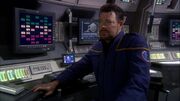
Riker at the engineering station of the NX-class Enterprise
"These Are the Voyages..." is the 22nd episode of the fourth season and series finale of Star Trek: Enterprise.
In 2161, the bridge officers of the NX-class spacecraft Enterprise have a casual discussion on the bridge of their ship, Captain Archer exiting from his ready room midway through the conversation. The officers mention both an upcoming ceremony – the signing of a charter between the members of an interstellar alliance, for which Archer is busy writing a speech – and the similarly imminent decommissioning of Enterprise, which Archer intends to postpone until after the charter has been signed.
Following a vocal command that signals all senior officers to report to the bridge, a bearded William T. Riker – having been quietly sitting at Enterprise's engineering station, dressed as a 22nd century Starfleet ensign of the command division – states a directive for a computer to "freeze program"; the environment of Enterprise's bridge and the other officers therein are actually holograms, and Riker's instruction was to the computer of the real ship he is aboard. After Riker saves and ends the simulation, the resultant change in his surroundings and uniform reveal he is, in fact, serving as a commander and is in the holodeck of the USS Enterprise-D, which he promptly exits...
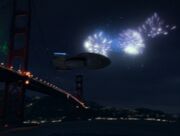
Voyager flying over the Golden Gate
"Endgame" is the 25th episode of the seventh season and series finale of Star Trek: Voyager.
2404: Fireworks light up the San Francisco night. The long-lost Federation starship Voyager, now returned from its 23 years of travel in the Delta Quadrant, buzzes the Golden Gate Bridge spanning San Francisco Bay, then climbs and twirls like a dancer among the fireworks. Huge, watching crowds cheer lustily.
But the whole thing is revealed to be recorded footage in a news transmission celebrating the tenth anniversary of Voyager's return. In her apartment, with lights off, Vice Admiral Kathryn Janeway watches the transmission. She has the computer end the transmission, and looks sadly out of her window, a dented coffee cup from Voyager sitting on a nearby table serving as a reminder of what happened during their long journey home.
2378: Lieutenant jg Tom Paris is awakened by the urgent, insistent voice of his very pregnant wife, Lieutenant B'Elanna Torres, telling him "It's time." They are in their quarters aboard Voyager. He is at first reluctant to rise, but then realizes what she means: she is in labor. Immediately he is out of bed, fully awake, and contacts The Doctor. In his haste, he does not bother to dress, dashing hurriedly into a robe and accompanying his wife out the door and on the way to sickbay...

A view of the Promenade on Deep Space 9 in 2375, looking down from the upper level
The Promenade was a wide, multi-level commercial and service area at the center of starbase Deep Space 9, serving as the hub for the station's civilian activities.
As a major thoroughfare, many visitors and station inhabitants progressed through the Promenade on their way from the docking pylons, docking ring and habitat ring to the central core. Several airlocks provided pedestrian access to the Promenade from the docking and habitat rings, and numerous turbolifts linked the Promenade to all other parts of the station. As young boys, Jake Sisko and Nog often passed time perched on the edge of the Promenade's upper level, watching passengers of various ships disembarking at the airlocks below. Before Nog left to attend Starfleet Academy, he joked to Jake that they had spent 2,147 hours there. They were often moved on by Security Chief Odo, though he later revealed to Jake that it was Nog (rather than Jake) that he was chasing away.
The Promenade also served as the primary public meeting place on Deep Space 9, offering places to congregate and socialize, sit, eat, drink, play games, worship and shop. A number of essential station facilities were situated on the Promenade, including the security office, the infirmary, the Bajoran temple, and the assay office. There was also an information kiosk.

The Sword of Kahless, one of the most important artifacts of Klingon history
Like its people, the history of the Klingon Empire is violent but colorful.
Around the year 900 AD, Qo'noS was ruled by Molor, a tyrannical ruler who was generally unpopular among the people. Kahless the Unforgettable emerged as a champion of the people, and slew Molor in single combat using the first bat'leth, the Sword of Kahless, in the Battle of Qam-Chee. Here, Kahless and the Lady Lukara fought a pitched battle in the city's Great Hall against the soldiers of Molor. While the rest of the city's garrison fled before the five hundred soldiers, Kahless and Lukara stood their ground and defeated the forces. Shortly after their victory, the two began what would become known as the greatest romance in Klingon history. Kahless ruled together with his new wife as Emperor of Qo'noS, building his new empire and also defeating the Fek'Ihri, despite the fact that he was not of noble birth. Kahless proved to be not only a powerful warrior, but a wise and just ruler, establishing a code of honor that was to become the template for Klingon society for centuries to come. Moreover, the defeat of Molor continues to be celebrated in the Empire in the Kot'baval Festival.
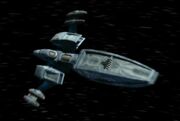
The Kumari, an Andorian battle cruiser
The Andorian battle cruiser was a type of warship in service with the Andorian Imperial Guard during the mid-22nd century.
The Andorian battle cruiser was considerably more rugged than the designs utilized by contemporary United Earth Starfleet vessels. Like all Andorian combat vessels, the Andorian battle cruiser was constructed using a "significant quantity" of duranium alloy. Despite the vessel's fairly large size, it was crewed by a complement of only eighty-six. In comparison, Starfleet's smaller NX-class had a standard compliment of eighty-three.
The outboard plan of the Andorian battle cruiser's design consisted of a central "spine" that contained a vertically bifurcated forward hull containing several decks. The central "spine" gradually narrowed toward the aft section of the ship where it connected to two vertically stacked warp nacelles. Located midway down the "spine" were a pair of forward-swept wings which contained the impulse engines and defensive systems.
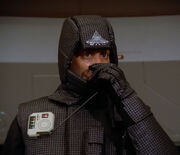
Q, as a soldier of one of the armies of World War III
Rising from the ashes of the Eugenics Wars of the mid-1990s, the era of World War III was a period of global conflict on Earth that eventually escalated into a nuclear cataclysm and genocidal war over issues including genetic manipulation and Human genome enhancement. World War III itself ultimately lasted from 2026 through 2053, and resulted in the death of some 600 million Humans. By that time, many of the planet's major cities and governments had been destroyed.
The war was fought in an era where various factions were known to control their military with narcotics. Among the parties involved was the Eastern Coalition (also referred to as "the ECON"), whose direct attacks included those against the United States of America. In 2026, at the start of the war, Colonel Phillip Green led a faction of eco-terrorists that was responsible for the loss of 37 million lives.
Colonel Green's activities during the war were often cited as "genocidal" and treacherous. He and his troops personally killed hundreds of thousands of individuals affected with radiation sickness and other "impurities," using as a rationale that it was necessary in order to prevent their passing on such traits to later generations. He was notorious into the 23rd century for striking at his enemies in the midst of negotiating with them.
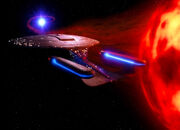
The Enterprise drifts towards the stellar matter
"Evolution" was the first episode in the third season of Star Trek: The Next Generation.
The USS Enterprise-D orbits a red giant and some stellar matter. Suddenly, something rocks the Enterprise. Picard quickly orders Wesley Crusher to stabilize, but the ship isn't responding. In engineering, La Forge reports that there is nothing wrong with the inertial dampeners. Back on the bridge, Worf says they are heading straight into the path of the stellar matter. The captain orders shields up but Worf cannot; "the shields will not respond," he shouts, as the ship drifts towards the stellar matter with only thirty seconds until impact.
Picard orders a manual override on the shields while Riker tells La Forge to reset the inertial dampeners. The shields begin to rise but the inertial dampeners are still unresponsive. The chief engineer activates the impulse engines in full reverse, which seems to stabilize the ship, but the momentum is still carrying the Enterprise into the stellar matter. Data reports that all systems are reporting normal. Picard asks the computer what the cause of the control malfunction was but the computer has no record of any such error. Confused, he checks Data's console, but everything appears normal.
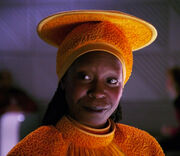
Guinan in Ten Forward
Guinan was the mysterious bartender at Ten Forward, the lounge aboard the USS Enterprise-D. She was well known for her wise counsel which had proven invaluable many times. She was an El-Aurian, a race of "listeners" who were scattered by the Borg. Q, however, once suggested that there was far more to Guinan than could be imagined. One can only speculate as to the meaning of this.
Guinan was born some time before Earth's late 19th century on the El-Aurian homeworld. When she was a child, she had a Tarkassian razorbeast as an imaginary friend. When she was troubled she'd talk to it, and she enjoyed just curling up on his warm belly. As she grew older, she found that she talked to it less and less, but the idea always remained.
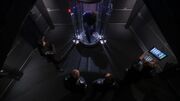
Enterprise's agony booth, a new invention
"In a Mirror, Darkly" is the eighteenth episode of the fourth season of Star Trek: Enterprise and the first episode of a two episode arc.
- "Captain's starlog – January 13, 2155. We've left Gorlan Station and have set a course to rendezvous with our assault fleet. Major Reed and the doctor have asked for a few minutes to show me their latest project."
Aboard the ISS Enterprise, Reed and Dr. Phlox demonstrate their new invention of an agony booth to Captain Maximilian Forrest and First Officer Jonathan Archer, using the booth on a Tellarite officer named Terev. The observers discuss attributes of certain torture methods. Although Reed is unsure why Terev is being punished, the Major believes all Tellarites are guilty of something. Captain Forrest exits, followed out by Archer.
In a corridor, Archer reminds the captain of a proposal he made to venture into Tholian space, as Archer has received news of a technology there that would give the Terran Empire the upper hand against the rebellion. However, Forrest wants to help the Empire's assault fleet annihilate the rebels, as ordered by Starfleet...
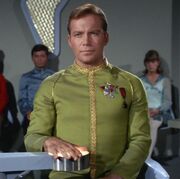
Kirk on trial
"Court Martial" was the 14th episode produced, and the 20th episode to air, in the first season of Star Trek: The Original Series.
- "Captain's Log, stardate 2947.3. We have been through a severe ion storm. One crewman is dead. The ship's damage is considerable. I have ordered a nonscheduled layover on Starbase 11 for repairs."
In Commodore Stone's office on the surface based facility of Starbase 11, Captain Kirk is reading over his sworn testimony as the commodore looks over a wall display, showing the repair status of several starships. Commodore Stone calls for maintenance section 18, which is working on the USS Intrepid, to reschedule and work on the Enterprise, which is priority one.
Captain Kirk says that records officer Benjamin Finney was in the ion pod during the ion storm. He went to red alert and warned him to get out of the pod. But he was too late, and they had to eject it, killing him. Commodore Stone asks Kirk if he's sure he jettisoned the pod after calling red alert, which he confirms. The computer records delivered by Spock say he jettisoned it before calling red alert though, thereby placing the blame of Finney's death on Kirk. Commodore Stone restricts him to the base, and opens an official inquiry.
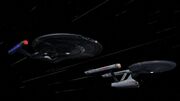
The ISS Avenger and the USS Defiant
"In a Mirror, Darkly, Part II" was the 19th episode of the fourth season of Star Trek: Enterprise.
On the bridge of the USS Defiant – having just witnessed the destruction of the ISS Enterprise by the Tholians – Commander Archer supervises Chief Engineer Tucker, T'Pol, and Major Reed, as the team desperately try to escape from a Tholian drydock that holds the Defiant. Even though they manage to shake the starship free from the facility's docking clamps, six Tholian ships approach and speedily construct an energy net over the opening of the dock, effectively barring the Defiant's escape.
With T'Pol's assistance, Tucker manages to restore power to the Defiant's weapon systems. The ship then blasts its way out of the dock, destroying half of the Tholian ships in the process and continues maneuvering away, firing photon torpedoes at the Tholian facility while departing. Reed detects escape pods from Enterprise, so Archer orders that they be brought aboard.
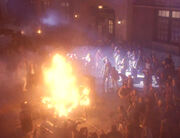
The Bell Riots begin
The Bell Riots were a pivotal series of events on Earth in 2024. Started in San Francisco's Sanctuary District A, they were named after protest leader Gabriel Bell.
In the year 2020, the American government – reacting to serious problems of homelessness and unemployment – created special Sanctuary Districts (essentially walled-off sections of the city grid) in most major cities. Unfortunately – while established with the benevolent intent of providing free housing and food, as well as prospects for future employment – the Sanctuaries, with little police protection and continued cutbacks, quickly degenerated into inhumane internment camps for the poor. Even though people with criminal records were not allowed inside Sanctuaries, it didn't take long for the homeless and unemployed to be joined by the mentally ill and other, more violent, social outcasts. These groups were later referred to by their slang terms – Gimmies, Dims, and Ghosts.
By late 2024, the twenty square blocks that made up Sanctuary District A had become overcrowded slums. With the records of people inside the Sanctuaries not uploaded to the planetary computer network (and therefore not accessible using an Interface), the true conditions inside were unknown to the general public. American society believed that, despite the political upheaval affecting Europe at the time, the United States was stable and had found a way to successfully deal with the social problems that had been the genesis of the Sanctuaries. An "out of sight, out of mind" mentality had set in.
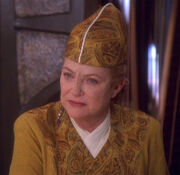
Kai Winn Adami in 2375
Winn Adami was an ambitious Bajoran religious leader and the first Kai of Bajor elected after the Cardassian Occupation. A member of a frequently outspoken orthodox order, Winn was steadfastly rooted in her faith and often came into conflict with the Emissary of the Prophets, Benjamin Sisko, who she considered an outsider unworthy of receiving the wisdom of the Prophets. After years of living in Sisko's shadow, however, and a lifetime of never receiving any guidance and affirmation from the Prophets who she had served and sworn allegiance to all her life, she eventually turned against them.
During the Occupation, Winn was imprisoned for five years for teaching the faith of the Prophets. She received numerous beatings at the hands of the Cardassians for her beliefs. Winn resented the belief of some members of the Bajoran Resistance that they alone had saved Bajor, since she had faced as much danger and suffering as they, but she did not have weapons to protect her.
As a Ranjen, Winn once convinced the head of her order to take a more active role in helping the Bajoran people. He allowed her to remove gemstones from their tabernacle, with which she used to bribe Cardassian officers for small acts of kindness.
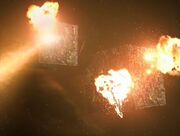
Resistance is not futile
"Scorpion" was the 26th and final episode of the third season of Star Trek: Voyager.
In a region of space, two Borg cubes are seen. They are advancing on their next intended targets for assimilation. Their hail is cut off abruptly as energy beams lash out at the cubes, which are instantly destroyed.
On one of the USS Voyager's holodecks, Captain Kathryn Janeway is running a Leonardo da Vinci holo-program, conversing with a Leonardo hologram in a simulation of the historical figure's workshop. She receives an urgent hail from Commander Chakotay, who urges her to go to engineering to take a look at something.
There, Lieutenant B'Elanna Torres explains that the long-range probe they sent out months ago has stopped transmitting. However, she was able to catch the last few seconds of telemetry, which show a Borg drone's face staring into the viewscreen.
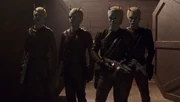
Andorian members of the Imperial Guard in 2151
The Andorians were a warp-capable humanoid species from the moon Andoria, capital of the Andorian Empire. In 2161, their homeworld became a founding member of the United Federation of Planets.
Most Andorians were blue-skinned with white or silver hair. An Andorian subspecies called the Aenar had white skin and, unlike blue Andorians, were blind and telepathic. Andorians and Aenar were genetically compatible and could produce offspring.
Andorians, with a higher metabolic rate than Terrans, were especially vulnerable to phase pulse infection; even minor phase injuries could prove fatal. However, they have demonstrated resistance to a wide range of environmental conditions. In a climate where the temperature is near the boiling point of water, an Andorian could still thrive, despite losing 10% of their body weight in two days.
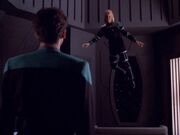
Bashir and Melora in a zero gravity environment
"Melora" was the 6th episode of the second season of Star Trek: Deep Space Nine.
Doctor Bashir and Lieutenant Dax are in the infirmary, testing a wheelchair designed for Ensign Melora Pazlar. Dax expresses amazement that the specifications are even in the replicator's database, saying she hasn't seen a wheelchair in over three hundred years. Bashir reveals that they weren't. It was, in fact, Pazlar herself who had sent him the design, due to the fact that her normal anti-grav unit won't work on Deep Space 9, a situation that Bashir likens to the troubles they had with integrating Starfleet cargo lifts. Before they can discuss it further, Major Kira chimes in over the comm system, informing Bashir that the Yellowstone has just docked at airlock 14. The doctor responds, telling her they're on their way, before taking the wheelchair and heading out with Dax.

The Xindi probe firing on Earth
The Xindi incident or Xindi crisis was a series of events lasting nearly a year, from March 2153 to February 2154, involving the Enterprise NX-01's attempt to save Earth from destruction by the Xindi. It was a major turning point in the Temporal Cold War, and the incident also helped pave the way for the creation of the Coalition of Planets, a precursor to the Federation.
In March of 2153, acting on false intelligence provided by the Sphere-Builders, the Xindi launched a surprise attack on Earth. The Xindi, who had been without a homeworld since the 2030s, had been informed by their protectors that, in the 26th century, Humanity was going to destroy their new homeworld.
Because of this, the Xindi-Primate scientist (and Xindi Council member) Degra had been working for several years on a weapon capable of destroying Earth.

Ambassador Picard and Q
"All Good Things..." was the 25th episode of the seventh season and series finale of Star Trek: The Next Generation.
Following an evening date at the holodeck, Worf and Troi walk back towards Troi's quarters. When Worf is about to kiss her goodnight, Captain Picard, dressed in his bathrobe, walks out of the turbolift, disoriented. Upon asking which date it is, he tells them he is moving back and forth through time.
Discussing the situation with Counselor Troi, Picard suddenly finds himself in the future, at his vineyard. After a short moment of disorientation, he goes on tying the vines. A pleasant surprise, La Forge decided to pay him a visit, coming all the way from Rigel III. He admits Leah told him of Picard's Irumodic Syndrome, and Picard tells him it takes years for the Syndrome to run its course.
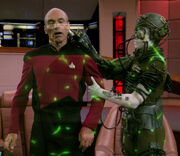
Picard kidnapped by the Borg
"The Best of Both Worlds" was the 26th and final episode of the third season of Star Trek: The Next Generation.
Commander Riker, Data, Worf, and Geordi La Forge file into a transporter room. Worf notifies Riker that there has been no contact from the surface of Jouret IV for over twelve hours, nor any signs of life. Immediately after the away team is beamed down by Transporter Chief Miles O'Brien, the team finds not only that the entire colony of New Providence has been completely destroyed but also that the colony's former town-center is now nothing more than a giant crater.
As the Enterprise flies alongside an Excelsior-class transport ship, Hanson and Shelby inform Captain Picard and Riker – in Picard's ready room – that Starfleet is unprepared for a potential Borg incursion, despite having known for over a year that they are coming. The officers discuss whether the colony was destroyed by the Borg and refer to the Enterprise's first contact with them, at System J-25 a year ago. Hanson asserts that Shelby – an expert on the Borg – will lead the investigation.
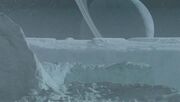
The frozen Northern Wastes of Andoria
"The Aenar" is the fourteenth episode of the fourth season of Star Trek: Enterprise and the third episode of a three episode arc.
Admiral Valdore gazes out a window on Romulus as Senator Vrax complains that the mission they were assigned to has become a disaster. The Romulan Senate expected them to cause political discord throughout the Alpha and Beta Quadrants but, for the first time ever, the Andorian and Tellarite governments have now formed an alliance.
Aboard Enterprise, T'Pol informs Archer, Reed, Trip, Phlox, and Shran that the drone-ship is being navigated using telepresence - a process which allows remote operation of a vessel. Shran comments that in the past, the Andorians experimented with telepresence for a short period of time. T'Pol suggests that Enterprise build their own telepresence unit to interfere with the Romulans' navigation of the drone-ship, but they must go to Andoria and seek the help of the reclusive Aenar to accomplish this.
Archer and Shran beam down to the frozen Northern Wastes of Andoria, Archer remarks at how cold it is and Shran informs him that Andoria is midway through its hottest season. The captain and Shran begin to search for the entrance to the Aenar compound when, suddenly, the ice gives way beneath Shran and he falls to the base of the slope...
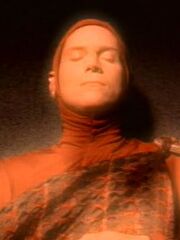
Bareil finds Prylar Bek's dead body in his orb experience
"The Collaborator" is the 24th episode of the second season of Star Trek: Deep Space Nine.
In an orb experience, Vedek Bareil exits the Bajoran temple on Deep Space 9 to find the Promenade conspicuously deserted. He wanders around until he finds the corpse of an anonymous Prylar hanging limply from the second level. Unsettled, Bareil passes by a non-functioning computer terminal and finds Major Kira Nerys near the stairway to the second level, dressed for springball and bouncing a ball against the wall with her paddle. "Wanna play?" she offers, although he is dressed in his Vedek robes. He looks back at the Prylar's body and desperately asks Nerys to help him. "Alright," she replies in an impatient tone. Kira runs up the stairs to the second level of the Promenade and approaches the rope from which the corpse is hanging. As she cuts the rope, the corpse falls to the ground and Bareil recognizes Prylar Bek. However, Nerys disagrees, claiming it is Bareil as the orb experience ends.
Bareil stands shirtless in his guest quarters on Deep Space 9 gazing at the stars, when Kira wishes him good morning as she embraces him from behind. He remarks that he thought she would sleep until noon after which Kira reminds him he is supposed to be relaxing. He reassures her he is very relaxed and asks how she is feeling. She claims she is miserable because she wishes he could stay longer; after pretending to consider the issue for a moment, Bareil declares that he will do so for a few more days. However, the election of the Bajoran Kai is at hand – an election Kira is sure Bareil will win. After all, it is common knowledge that Bareil was Kai Opaka's hand-picked successor...
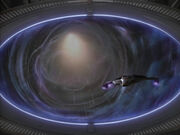
The first of many Jem'Hadar ships to come through the wormhole
"The Jem'Hadar" is the 26th and final episode of the second season of Star Trek: Deep Space Nine.
Commander Benjamin Sisko, Jake, Nog, and Quark have entered the Gamma Quadrant to conduct a planetary survey for the boys' upcoming science project in school.
On the station, the USS Odyssey is due to arrive in eight hours when something begins coming through the wormhole. Kira tells Dax to display it on the viewscreen and it is a Jem'Hadar attack ship. Dax hails the vessel and raises the station's shields, but a Jem'Hadar beams into Ops despite the shields. O'Brien activates a containment field around the intruder and Kira introduces herself before telling the Jem'Hadar it is "customary" to identify oneself before beaming into someone else's command center.
The Jem'Hadar introduces himself as Third Talak'talan of the Jem'Hadar and informs Kira that Commander Sisko has been detained indefinitely. Sisko, he says, will serve as an example to anyone who interferes with the Dominion by coming through the wormhole. Dax defiantly tells him that idle threats will not stop the Federation from exploring the Gamma Quadrant, so he walks through the force field and gives Kira a Bajoran PADD with a list of vessels he says have been destroyed for violating Dominion territory. The PADD came from New Bajor, he tells her, adding that they fought well for a "spiritual" people. He beams back aboard his ship and O'Brien attempts unsuccessfully to lock on with a tractor beam as it re-enters the wormhole...

Kohl stasis pods
"The Thaw" was the twenty third episode of the second season of Star Trek: Voyager.
As Voyager approaches a deserted planet, Lt. Tuvok notes that there are nonfunctional communication satellites in orbit. Evidence suggests an advanced culture with warp drive and similar technologies, but Kim announces that evidence indicates a major solar flare occurred nineteen years previously. There are no life signs and it appears that the atmospheric disturbances would have prevented any escape attempts. Janeway grimly realizes that the entire colony of 400,000 people was likely wiped out, however, Kim announces that they are being hailed from the planet's surface.
Janeway tells Paris to play the message. A man named Viorsa appears and introduces himself as the planner of the Kohl settlement. He explains that Voyager's sensors have activated the message and that the Kohl have gone into a state of artificial hibernation in order to survive the effects of the ecological disaster on their world. The computer will awaken them in fifteen years, and he asks that no one interrupt their timetable. Chakotay points out that the colonists' timetable ended four years ago...
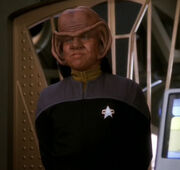
Nog in 2375
Nog was a Ferengi, the son of Rom and Prinadora, and the nephew of Quark. He was the first Ferengi to enter Starfleet, and served aboard Deep Space 9 and the USS Defiant during many of the most important battles of the Dominion War.
As a young Ferengi, Nog was required to memorize the Rules of Acquisition and study the philosophy of the Great Material Continuum. In time, he was expected to become a merchant and to acquire wealth like a good traditional Ferengi male. At some point during the latter years of the Cardassian Occupation of Bajor, Rom and Nog took up residence on Terok Nor and began work as waiters in Quark's bar. In 2369, Nog was still living on Terok Nor when the Cardassians withdrew.
Nog quickly met Jake Sisko, Commander Sisko's son, as there were only a few children on the newly renamed Deep Space 9 after the Bajoran Provisional Government asked Starfleet to take over administration of the station. As a result, Jake and Nog spent a lot of time together and soon became close friends. They had many adventures and misadventures together and often engaged in mischief; occasionally getting in trouble for playing pranks on the station. Much of their time was spent on the Promenade, where they watched the passengers disembark.
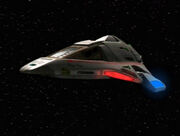
The Delta Flyer
The Delta Flyer was a unique Starfleet shuttlecraft constructed by the crew of the USS Voyager in the Delta Quadrant in 2375. The vessel was designed to handle environments that would be too hazardous for a standard shuttlecraft. The vessel was a blend of Starfleet and Borg technology, designed in collaboration between B'Elanna Torres, Tom Paris, Tuvok, Harry Kim, and Seven of Nine. It featured an ultra-aerodynamic tetraburnium alloy hull, retractable warp nacelles, parametallic hull plating, unimatrix shielding, and a Borg-inspired weapon system, including photonic missiles. To Paris' disappointment, the addition of dynametric tailfins was denied by Tuvok.
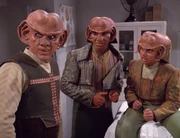
Three Ferengi males: Quark, Rom, and Nog
The Ferengi were a spacefaring humanoid species native to the planet Ferenginar. Ferengi civilization was built on the ideals of pure laissez-faire capitalism, in which all other goals were subjugated to the pursuit of profit.
Their governing body, known as the Ferengi Alliance, was formed over a period of ten thousand years, beginning with the establishment of a system of currency, to their purchase of warp technology, and finally to its current state in the 24th century.
The Ferengi culture had roots similar to that of the many other species, filled with wars, violence, and greed. However, Ferengi managed to avoid many of the worst aspects of an evolving culture and their social history is notable for the absence of atrocities such as slavery or genocide, a distinction the Ferengi felt makes them morally superior. Ferengi culture slowly grew out of its early stages by introducing a remarkable economic system that developed from early bartering systems to become one of the leading cultures in interstellar commerce.

Gral, a Tellarite male
The Tellarites were a sturdy humanoid species with distinguished snouts from the planet Tellar Prime, located not far from the Sol system. In 2161, they became one of the founding races of the United Federation of Planets.
Tellarites were known to be an impatient people with "stubborn pride". They had a propensity toward strong emotion. However, they enjoyed a good argument, which was even considered a sport on Tellar. Tellarites often began an interaction with a series of complaints; this was how they started arguments with someone they had recently met. If they had nothing to complain about, they simply insulted the person. Because of their passion for arguing, Tellarites made excellent politicians. Tellarites considered canines to be something of a delicacy. They sometimes took mud baths and found Human room temperature to be cold.
In November of 2154, a Tellarite delegation, lead by Ambassador Gral, was being transported to the planetoid Babel by Enterprise to resolve a long-standing trade dispute with the Andorians. The original conference agenda covered only trade regulations for the sector. A subsequent Romulan plot to destabilize the region had the opposite effect and created a temporary alliance among the Andorians, Vulcans, Humans, and Tellarites. The proceeding conference later helped bring peace to the strained Tellarite-Andorian relations.
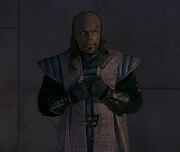
Colonel Worf in 2293
Colonel Worf was a prominent Klingon advocate and diplomatic figure in the late 23rd century.
In 2293, Worf represented Captain James T. Kirk and Dr. Leonard McCoy when they were put on trial on the planet Qo'noS, in suspicion of involvement in the assassination of Chancellor Gorkon. While Worf was powerless to prevent the pair being convicted in what was essentially a show trial, he nonetheless managed to convince a trio of judges who were presiding over the case that the evidence was not strong enough to support the death penalty. He noted that Gorkon's assassins could have merely been wearing Starfleet uniforms rather than being members of Starfleet themselves. Due to this line of deliberation, combined with the closeness of an impending peace summit, the sentence was commuted to a lifetime's imprisonment on Rura Penthe.

Kronos One, a K't'inga-class battle cruiser
The K't'inga-class battle cruiser was the primary class of warship in service with the Klingon Imperial Fleet from the late 23rd century through the late 24th century.
Introduced in the early 2270s, the K't'inga-class cruiser was considered one of the most powerful warships in the Klingon Defense Forces, even serving as a flagship of the Imperial Fleet for a time during the 2290s.
K't'inga-class cruisers were in service as early as 2272, when the Epsilon IX station recorded the destruction of three K't'inga-class vessels by the V'Ger entity. Starfleet's interest in the K't'inga-class cruiser was such that in 2285 the class of ship appeared in the Kobayashi Maru training scenario at Starfleet Academy. Interest in these vessels by the Federation would continue to appear well into the 2370s, as data on this class would commonly be found within numerous Starfleet files.
For nearly a century, the K't'inga-class cruiser proved to be a rugged, sturdy design that saw continuous use. In that they were much like their Federation counterparts the Excelsior and Miranda-class starships, whose usefulness out-lived contemporaries such as the Constitution-class cruiser.
With marked improvements, these warships saw continuous use as front line and border patrol ships throughout the Second Klingon-Federation War and the Dominion War of the early-2370s. They were not always the ship of choice for all missions, however, as more agile craft like the Klingon Bird-of-Prey were better suited for some tasks.
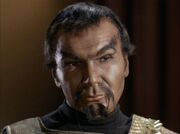
Kor in 2267
Dahar Master Kor, son of Rynar, the last son of the House of Kor and descendant of the Klingon Imperial Family, was among the most influential warriors and respected military leaders of the Klingon Empire during the late 23rd and early 24th centuries.
Throughout his illustrious career, Kor played key roles in the Empire, including his confrontation with the equally legendary James T. Kirk on Organia, his attack on Romulus, his defense of the Korma Pass, and the discovery of the Sword of Kahless.
Welding a ruthless reputation toward those who stood in his way, Kor's influence granted him the military governorship of Organia, as well as a command of his own – the IKS Klothos. It earned him a seat on the Oversight Council, and bestowed him the status of Klingon Dahar Master. In his waning days, Kor found his exploits caught up with him, and he fell from the graces of the Empire, before ultimately dying a warrior's death.
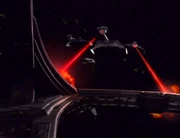
The Klingons attacking DS9
The First Battle of Deep Space 9 opened the Federation-Klingon War of 2372-2373. In early 2372, shortly after an overwhelming invasion of the Cardassian Union by the Klingon Defense Force, a task force led by Chancellor Gowron and General Martok launched an attack on the Federation space station of Deep Space 9, in an attempt to force Captain Benjamin Sisko to relinquish the members of the Cardassian government under his protection.
The Klingon fleet consisted of over fifty warships including at least thirty-four Birds-of-Prey, six Vor'cha-class attack cruisers, and eleven K't'inga-class battle cruisers. The IKS Negh'Var served as the flagship. Starfleet had used the year leading up to the battle to prepare the station for a massive attack by the Dominion, and these preparations included the installation of new torpedo launchers and phaser emitters, as well as a stockpile of five thousand photon torpedoes.
The Klingons underestimated the station's defenses, and were unable to take the station before the arrival of Starfleet reinforcements. Faced with the prospect of massive losses and an escalating war on two fronts, Gowron ordered his forces to withdraw.
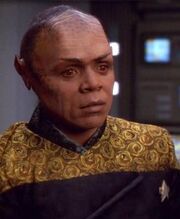
Tuvix in 2372
Tuvix was the result of a transporter accident on the starship USS Voyager, combining Lieutenant Tuvok and Neelix in 2372.
The accident was the conclusion to an away mission to collect some orchid samples. Only one molecular pattern rematerialized and formed a healthy organism combining everything regarding Tuvok and Neelix, including organs, enzymes, and memories. According to The Doctor, Tuvix also possessed "...Tuvok's sense of intellectual superiority, and Neelix's annoying ebullience." Despite repairs having just been made to the transporter, no fault could be found in the logs at the time of the accident.
It was Tuvix, the name the combined individual had given himself, who realized what had happened. The plant samples, which were also caught up in the matter stream and were also a part of Tuvix, contained lysosomal enzymes. Tuvix' research indicated that this could be an indicator of symbiogenesis, where an organism reproduces by merging with a second species to produce a hybrid. This usually only occurs with microcellular organisms. Tuvix suggested that being deconstructed during beaming allowed the symbiogenesis enzymes of the plant to react to Neelix' and Tuvok's DNA in the matter stream, so only the single organism existed at the point of rematerialization. The theory turned out to be correct when two plants and the orchid were beamed up together, resulting in one plant arriving on Voyager.

René Auberjonois
René Auberjonois was the actor best known to Star Trek fans for portraying Constable Odo on Star Trek: Deep Space Nine. He has also directed many episodes of the series. In addition, he appeared as Col. West in Star Trek VI: The Undiscovered Country and made a guest appearance as Ezral in the Star Trek: Enterprise episode "Oasis".
Auberjonois has been performing on the Broadway stage since the late 1960s, receiving a Tony Award for Best Featured Actor in 1970. He has also become a highly-recognizable face in films, including several directed by the late Robert Altman and co-starring John Schuck. He also acquired fame on television for his Emmy-nominated role as the snooty Clayton Endicott III on the sitcom Benson, which co-starred Star Trek: Voyager star Ethan Phillips. Recently, Auberjonois starred opposite William Shatner on the hit ABC series Boston Legal.
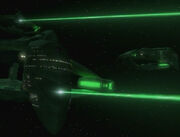
D'deridex-class warbirds in 2374
The massive D'deridex-class, or type-B, Warbird was one of the most advanced vessels in the Romulan Star Empire and served as the backbone of the Romulan fleet during the mid-to-late-24th century.
Roughly twice as long as a Federation Galaxy-class starship, the D'Deridex-class Warbird had a notable advantage in fire power, over its Federation counterpart, but a lower overall maximum speed and less combat maneuverability.
Like earlier Romulan warships, D'deridex-class Warbirds were equipped with cloaking devices, which protect them from detection in most evasive situations. However, cloaked Warbirds radiated a slight subspace variance at warp speeds; therefore ships traveling at speeds above warp 6 run a much greater risk of being detected through their cloak. While traveling under cloak, all electromagnetic emissions, including communications, aboard a Warbird were carefully monitored.
The emergence of a D'deridex-class Warbird in 2364, during an encounter with the USS Enterprise-D on the edge of the Neutral Zone, signaled the end of a fifty-three year Romulan isolation.

The eleven-foot model
During the production of the Star Trek television shows, most notably Star Trek: The Original Series, numerous studio models were created representing the Constitution-class, in particular the USS Enterprise, more than for any other class of starship. Starting out with traditional physical studio models, advances in technology have resulted in digital versions that were added to the array of models used in the Star Trek franchise.
As art director on the original series, Matt Jefferies was given the assignment to design the Enterprise itself. His only guideline was Gene Roddenberry's firm list of what he did not want to see: any rockets, jets, or fire-streams. The starship was not to look like a classic, and thus dated, science-fiction rocket ship, but neither could it resemble anything that would too quickly date the design. Somewhere between the cartoons of the past and the reality of the present, Matt Jefferies was tasked with presenting a futuristic design of his own.
The theory that space could be warped – a hypothetical means of faster-than-light travel – had first been proposed by Albert Einstein in 1905. Years later, Star Trek itself would establish that Zefram Cochrane had first demonstrated warp drive in 2063. In the 1960s, however, warp drive – a delicately balanced, intricate web of chemistry, physics, mathematics, and mystery – initially perplexed Matt Jefferies.
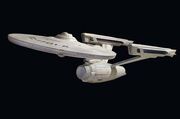
The eight-foot refit model
The studio models that represented the Constitution-class USS Enterprise were slated to be modernized and redesigned after the production of Star Trek: The Original Series and Star Trek: The Animated Series. Starting out with traditional physical studio models, digital versions were also used to represent ships of this class in the Star Trek franchise.
Ralph McQuarrie, best known to the public for his stunning production designs for the Star Wars films, was hired by Ken Adam to help develop the designs for the new Star Trek: Planet of the Titans movie, ultimately abandoned to make way for Star Trek: Phase II, the new television series. Although the design used the same elements as the original design, saucer shaped primary hull, warp engine assemblies and a engineering secondary hull, the secondary hull was flattened and wedge shaped, providing a radically different look, one not unlike the Star Destroyers McQuarrie designed for those films.
Their Enterprise design, however, was abandoned, and Roddenberry asked Matt Jefferies to update the famous starship to reflect the refit that would be part of the Phase II-series' back story. During June 1977, Jefferies' re-designed the engine nacelles from tubes to thin, flat-sided modules, and tapered their supports. He also added the distinctive photon torpedo launch ports on the saucer connector.
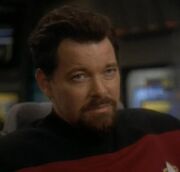
Thomas Riker in 2371
Thomas Riker was the result of a transporter accident in 2361 that created two William T. Rikers indistinguishable from each other. Eight years later, the USS Enterprise-D discovered Thomas on Nervala IV, the site of the accident, where he had been living in seclusion. Because of this seclusion, Thomas had remained deeply in love with Deanna Troi, and dwelt on the fact that he was unable to meet her on Risa later in the year of the mishap. Troi was reluctant to get involved with Thomas, but he eventually won her over, but when he had to leave the Enterprise-D, her feelings were not strong enough for her to leave with him. Thomas transferred to the USS Gandhi to continue his Starfleet career.
The following year, Thomas expressed dismay at the Federation's policies towards the Demilitarized Zone and joined the Maquis. Early the next year, Thomas posed as William Riker, boarded Deep Space 9 and stole the newly commissioned USS Defiant. With Kira Nerys as his unwilling passenger, Thomas flew to the Orias system where the Maquis believed that the Cardassians were building a fleet of warships. When they arrived, the Defiant was confronted by a fleet of Obsidian Order starships. Thomas surrendered himself to Gul Dukat's forces and received a life imprisonment sentence in a labor camp on Lazon II.
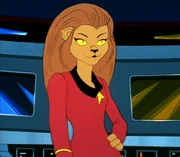
Lieutenant M'Ress
Lieutenant M'Ress was a Caitian Starfleet operations division officer who served aboard the USS Enterprise under Captain James T. Kirk during the final two years of his five-year mission.
M'Ress' primary role on the Enterprise was that of the relief communications officer, a role she fulfilled in the absence of Lieutenant Uhura. Her duties included activating intership and intraship communications, as well as the activation of any alert signals ordered by the captain.
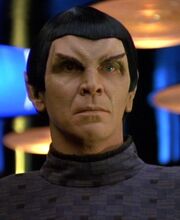
Telek R'Mor
Doctor Telek R'Mor was a low-ranking Romulan scientist and minor functionary attached to the Romulan Astrophysical Academy during the mid-24th century.
In early 2350, Dr. R'Mor began a three-year mission, conducting "secret research" aboard the science vessel Talvath. According to a claim he later made, R'Mor had a wife and daughter who lived on Romulus. His daughter was born several months into his mission. He knew, when he accepted his assignment, that he would pay the price of missing his family. After a year away from his family, he began to realize how high that price was.
In mid-2351, while traversing Sector 1385 of the Alpha Quadrant, the Talvath discovered a microprobe lodged in an eddy of a micro-wormhole. The Talvath made repeated scans of the probe and R'Mor soon received a vocal transmission from the other side of the wormhole, which identified itself as originating from "the Federation starship USS Voyager," stranded in the Delta Quadrant. Introducing himself only as the captain of a cargo vessel, he was unconvinced that Voyager was in the Delta Quadrant but instead believed it must really be from the Alpha Quadrant. He terminated communications, in fear that he had been discovered by Starfleet spies on a covert surveillance mission.
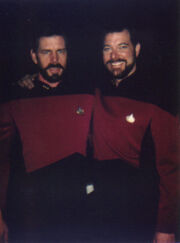
Morga and Jonathan Frakes
Thomas "Tom" A. Morga is a stuntman, stunt actor, and stunt coordinator who holds the record for being the most seen stuntman in Star Trek. Between 1979 and 2005 he appeared in six feature films and all four spin-off television series, doubled main actors and guest actors, and played almost every major race.
Morga also served as assistant stunt coordinator to Dennis Madalone on Star Trek: The Next Generation, Star Trek: Deep Space Nine, and Star Trek: Voyager for fourteen years. This position included fight choreographies for episodes such as "Blood Oath" and the creating of props such as the blade weapons in "Battle Lines". For the majority of his appearances he received no on-screen credits.
Outside of Star Trek, Morga has worked on numerous other films, including Ghost Busters, Alien Nation, Army of Darkness, The Shawshank Redemption, Independence Day, Spider-Man, and all three Pirates of the Caribbean films. His television credits have thus far included Scarecrow and Mrs. King, NYPD Blue, Babylon 5, Buffy the Vampire Slayer, and Seinfeld. Throughout his career, he has doubled such actors as Bruce Boxleitner, Jeff Goldblum, David Hasselhoff, John Travolta, and Star Trek Nemesis' Ron Perlman.
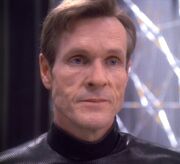
Luther Sloan
Luther Sloan was a Human operative of the clandestine intelligence agency Section 31. In his eyes, to protect what the Federation had worked hard to build, the ends justified the means and he was willing to do almost anything, even cutting ties to his family and friends and violating the Prime Directive.
In 2374, Sloan attempted to recruit Julian Bashir into Section 31's ranks, staging an elaborate deception using a holodeck in an attempt to test Bashir's loyalties. Soon after, Sloan gave Bashir his first "assignment" – observations of various members of the Romulan government during an upcoming Federation-Romulan conference on Romulus, and in particular Koval, the chairman of the Tal Shiar.
Sloan revisited Deep Space 9 when Bashir convinced Section 31 that he had devised a cure to the morphogenic virus infecting the Founders. Bashir and Miles O'Brien attempted to use Romulan mind probes to extract the information regarding the cure from Sloan's mind. Sloan triggered a lethal implant in his brain, committing suicide, but Bashir and O'Brien were able to prolong his life long enough to get the secret of the cure. Unfortunately, Sloan took the rest of his secrets about Section 31 to the grave with him.

... as a Starfleet ensign
Leslie Hoffman is a stuntwoman, actress, and stunt coordinator who worked as a stunt performer on Star Trek: Deep Space Nine and Star Trek: Voyager regularly between 1995 and 2001. In the early 1980s, Hoffman was the first "voted-in" member of the "Society of Professional Stuntwomen".
A self-avowed Trekkie, Hoffman attended the second Star Trek convention ever held in New York City in 1973. Her first work on Star Trek in DS9's "The Way of the Warrior" was a dream come true for her, and for the final five seasons of Voyager, she was the main stunt double for B'Elanna Torres actress Roxann Dawson.
Throughout her career, she has appeared in a wide variety of television shows, such as Charlie's Angels, Melrose Place, BJ and the Bear, and M*A*S*H, and films, such as Nightmare on Elm Street, Clue, Death Wish 3, and Alien Nation.
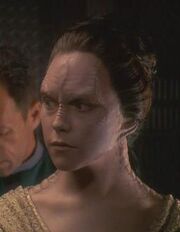
Tora Ziyal
Tora Ziyal was the illegitimate daughter of the Cardassian Gul Dukat and the Bajoran Tora Naprem, conceived during the Occupation when Dukat was in command of Terok Nor.
Although Dukat loved both Naprem and their daughter, he knew the Occupation was drawing to a close and that Ziyal would not be accepted on either Bajor or Cardassia Prime. Therefore, he sent the two of them away to live on the neutral planet of Lissepia, aboard the transport ship Ravinok in 2366. En route, the Ravinok was attacked and downed on Dozaria by Breen warships. Naprem was killed in the crash, while Ziyal and the other survivors were captured and forced to labor in a nearby Breen dilithium mine.
Six years later in early 2372, the fate of the Ravinok reached the outside world. Dukat learned that Major Kira Nerys was mounting a search for the transport and arranged to have himself join her. Dukat had intended to kill Ziyal if he should find her alive, as the fact he had an illegitimate half-Bajoran daughter posed a threat to his political position and legitimate family. Ziyal was aware of this fact from the other Cardassian prisoners, but she still hoped that her father would rescue her as her mother promised. When Dukat found her as he and Kira liberated the camp, Ziyal told him that she would rather die than to be apart from him. As he looked upon his daughter, Dukat found he could not kill her.
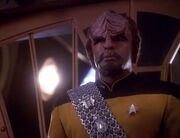
Worf arrives on DS9
"The Way of the Warrior" is the fourth season premiere of Star Trek: Deep Space Nine. Following a surprise drill aboard Deep Space 9, Kasidy Yates remarks to Captain Benjamin Sisko during a romantic dinner that there have been some changes on DS9, including a lot of "maintenance" being done on the station. Sisko is secretive, but hints that the crew is preparing a few "surprises" in case the Dominion decides to attack. The recent revelation that Changelings have infiltrated the Alpha Quadrant has caused a large amount of unrest, and the Cardassians have responded by sealing their borders.
Later, Sisko grants shore leave aboard the station to General Martok and his battalion of Klingon ships. The Klingons act suspicious and paranoid. Martok proclaims that the Klingon fleet will remain in Bajoran space to counter the inevitable Dominion attack. Odo ultimately breaks up an altercation between Morn and the Klingons. Later, the lead Klingon, Drex, and his thugs ambush and beat Elim Garak in his tailor shop. As Doctor Bashir mends Garak's broken bones, Garak wonders why the Klingons are suddenly so hostile towards Cardassians. Realizing something must be done before the situation escalates out of control, Sisko notifies Starfleet Command and Lieutenant Commander Worf is dispatched to the station. Sisko gives Worf an assignment – find out what the Klingons are up to.

Robert Picardo
Robert Picardo is the actor best known to Star Trek fans for playing Starfleet's Emergency Medical Hologram, or simply, The Doctor, on Star Trek: Voyager.
Picardo was born in Philadelphia, Pennsylvania on 27 October 1953. He attended William Penn Charter School, graduating in 1971, after which he attended Yale University. While attending Yale, he performed in several University productions and graduated with a BA in Drama in 1975.
In 1977, he made his Broadway debut in a production of Gemini, and in 1981, made his feature film debut in the contemporary horror classic, The Howling. His other film credits include Innerspace, Gremlins 2: The New Batch, Wagons East!, and more. In addition to his role on Voyager, he is also known for playing Dr. Dick Richard on China Beach, Coach Cutlip on The Wonder Years, and for his role as Agent Richard Woolsey in the Stargate television franchise.
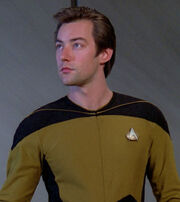
Darien Wallace in 2365
Lieutenant Darien Wallace was a Starfleet crewmember who served aboard the USS Enterprise-D from 2364 to 2371.
Wallace graduated Starfleet Academy at Beta Ursae Minor II. He served aboard many starships in his career including the USS Baton Rouge on stardate 47210.4, the USS Seaquest on stardate 47320.0, and the USS Enterprise beginning on stardate 47400.0. While serving aboard the Enterprise, he held the classification of specialist 3 in life support systems.
In the early 2360s, Wallace served at Utopia Planitia Shipyards in the Sol system. He was the team leader for primary hull forward life support control and emergency systems installation for the starship Enterprise-D. He was also assistant parts scheduler of the primary and secondary life support systems linkage system.
Wallace had many achievements throughout his career. On stardate 47100, he was awarded the J. Bruce Award for bioengineering. On stardate 47102, he was awarded the Extended Tour Ribbon and the Campbell Award for life sciences. He was promoted to the rank of lieutenant on stardate 46220.8.

... as a security officer
Patricia Tallman is a stuntwoman and actress who appeared in several episodes of Star Trek: The Next Generation, Star Trek: Deep Space Nine, and Star Trek: Voyager, and in the seventh feature film Star Trek: Generations.
Outside the Star Trek universe she is best known for her role as "Lyta Alexander", a telepath, on the science fiction television series Babylon 5.
Tallman first worked with Dennis Madalone on the set of Shocker, and this led to an appearance in the TNG episode "Power Play", where she played a security officer. This single appearance was followed by a long-term relationship with Star Trek, as Tallman became part of the core stunt group. Because of her height and resemblance she doubled lead actresses Gates McFadden and Nana Visitor – as well as several guest actresses – for the next eight years, played stunt acting parts as a Romulan, Bajoran, and several other aliens, and coordinated fight scenes in such episodes as "Looking for par'Mach in All the Wrong Places".
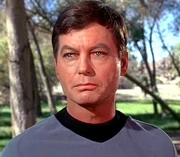
Leonard McCoy in 2267
Leonard H. McCoy, MD, was a noted Human physician and scientist of the 23rd and 24th centuries who served as ship's surgeon and chief medical officer aboard the Federation starships USS Enterprise and USS Enterprise-A for 27 years.
McCoy was an accomplished surgeon, xenophysician, exobiologist, and an expert in the field of space psychology. Born in the "Old South" region of North America on Earth, in 2227, McCoy was commissioned to Starfleet in the 2250s. In his early career he made numerous medical advancements in virology and neurology before being promoted to lieutenant commander.
He joined the USS Enterprise, under command of James T. Kirk in 2266, replacing the outgoing Dr. Mark Piper as chief medical officer and ship's surgeon. During his posting, Kirk liberally used the nickname, "Bones" (short for "sawbones", the ancient description of a surgeon) for McCoy and the name stuck for the remainder of their friendship.
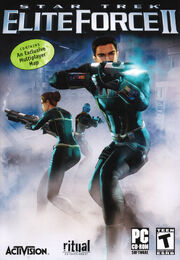
Star Trek: Elite Force II
Star Trek: Elite Force II is a follow-on to the hugely successful Star Trek: Voyager - Elite Force. Developed by Ritual Entertainment and published by Activision, the game is a first-person shooter that employs the talents of some of Star Trek's most recognized voice actors.
Following on from the original game, the player takes the role of Lieutenant Alexander Munro, a member of the specialist unit called the Hazard Team aboard the starship USS Voyager. Upon the ship's return from being stranded in the Delta Quadrant, the future of the Hazard Team is in doubt. Split up and posted to different assignments, the members of the Hazard Team return to their normal everyday duties. That is until Captain Jean-Luc Picard requests their help on the USS Enterprise-E.
Elite Force II possesses nearly double the levels of the original game with a story that takes the player from Starfleet Academy to the darkened halls of an abandoned Federation starship, to a secret base on the edge of the Romulan Neutral Zone. With new features such as tricorder puzzles, hidden secrets and in-game bonuses, Elite Force II has hours of additional gameplay action.
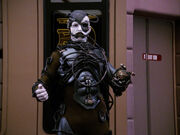
A Borg drone in 2366
Borg drones made up the population of the Borg Collective.
A drone was an assimilated individual augmented with Borg technology and capable of assimilating others, be it an individual or technology, into the Collective. After assimilation a drone possessed no sense of individuality and served only the Collective.
Although both male and females of any susceptible species could be assimilated, Borg drones themselves were neither male nor female in a reproductive sense. The physiology of Borg drones varied because various species were assimilated into the Collective. Their organic bodies were enhanced, and some parts completely replaced, with cybernetic implants. The nature of these implants was determined by the drone's intended function, such as a tactical or medical repair drone. Every drone was equipped with a homing device, which had its own unique translink frequency, by which it was kept in contact with the Collective through subspace transceivers, thus forming the hive mind. The original species of a drone was often considered by the Collective when assigning a function.
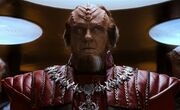
Gorkon in 2293
Gorkon was the Chancellor of the Klingon High Council in 2293. In this capacity, he notably pursued peaceful relations between the Klingon Empire and the United Federation of Planets. He was murdered just prior to the start of the Khitomer Conference, however. Only a full explanation of a conspiracy behind his murder allowed for successful negotiation of the Khitomer Accords, which eventually normalized relations between the two governments after years of hostility.
In 2293, the destruction of the Klingon moon Praxis forced the Klingon Empire to reassess its position towards the United Federation of Planets, as the Empire simply could no longer afford to maintain its massive military budget and deal with the devastating effects of the explosion on its economy. Gorkon approached the Federation via Captain Spock and opened negotiations that would see the military outposts on both sides of the Klingon Neutral Zone dismantled and a new alliance forged between the two cold war enemies.
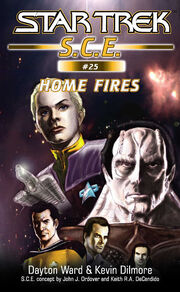
Home Fires - eBook 25
Home Fires is the 25th eBook in the Star Trek: Starfleet Corps of Engineers series. It is the first story covering the aftermath of the catastrophic Galvan VI incident, where half of the ship's complement were killed.
While the da Vinci undergoes repairs, the crew attempts to put their lives back together. The story follows Domenica Corsi's trip home to Fahleena III, accompanied by Fabian Stevens, and her relationship with her long-estranged father, the captain of a cargo company.
Domenica Corsi brings fellow crewmate Fabian Stevens, who she has yet to admit to herself is her boyfriend, home to meet her parents, with whom they will be staying for a week. At first her mother, Ulrika, greets them warmly and helps them get settled in for their stay. Domenica and her mother discuss Fabian's feelings for Domenica. The two, who are not quite dating, have gotten very close after recent events, including the near-destruction of the da Vinci at Galvan VI...
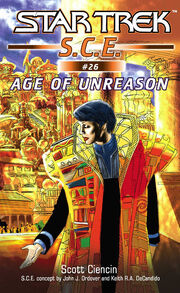
Age of Unreason - eBook 26
Age of Unreason is the 26th eBook in the Star Trek: Starfleet Corps of Engineers series. It continues the reactions of the da Vinci crew following the aftermath of the catastrophic Galvan VI incident, where half of the ship's complement were killed.
While the ship continues to be repaired, Carol Abramowitz, Bart Faulwell, and Soloman try to prevent a civil war on Vrinda. Carol is asked to host the ceremony that will begin a truce between the two warring powers, a ceremony involving an expression of honest, naked emotion, something she has never been particularly comfortable doing, especially after the events of Galvan VI.
On the planet Vrinda, Lord Farhan Tanek discusses the future of the Vardan religion and its people with his advisor, Enzo Clyvans. Tanek plans to use a new weapon to annihilate the Nasnan, a rival religious sect and Tanek's political enemy. Clyvans decides that the ensuing civil war would be too catastrophic for the planet and attempts to get to a communications tower located within a Vardan temple. He is able to transmit a signal to Starfleet Headquarters just before a security guard kills him...
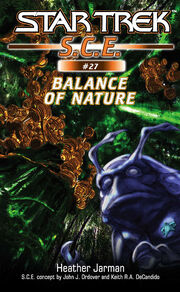
Balance of Nature - eBook 27
Balance of Nature is the 27th eBook in the Star Trek: Starfleet Corps of Engineers series. After the catastrophic events at Galvan VI, P8 "Pattie" Blue takes a trip home while her world is confronting a crisis that threatens the Nasat's very existence.
As P8 ("Pattie") Blue steps foot on the Nasat homeworld for the first time in years, a quake strikes, the first in sixteen seasons (or eight years, Federation standard). While trying not to fall off the ledge of the city built into the treetops kilometers in the air, many other Nasat are injured by the debris. She is also worried about a very important duffel bag she's carrying - which contains young larvae (her offspring). Nasat leave their young in special nursery buildings, and the young never meet their parents. Once the quake stops, she searches for her Betazoid friend "Zoë" who was there to meet her. The two of them try to treat injured Nasat, but a Nasat security guard tries to get everyone evacuated by order of the planetary council.
After finally giving up with arguing with officer, (as they've done all they can for the injured anyway) they head back to Zoë's paddock. Watching the news on Dr. Tarak's power cell viewscreen (as the power was out), P8 tries to figure out why the more sturdy buildings were destroyed while the older ones were reasonably untouched. She takes several frames and studies them, as Zoë catches up with her on her and Taraks research into "quiets," as well as her budding relationship with him...
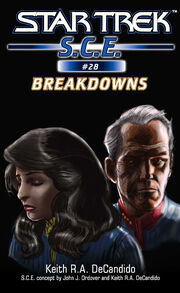
Breakdowns - eBook 28
Breakdowns is the 28th eBook in the Star Trek: Starfleet Corps of Engineers series, and the final book dealing with the crew's reactions to the aftermath of the catastrophic Galvan VI incident, where half of the da Vinci's complement were killed.
This final chapter focuses on Captain David Gold, as he contacts the families of the twenty-three members of his crew who died under his command to give his personal apologies, and Commander Sonya Gomez, who has to deal with the loss of Kieran Duffy, who had asked her to marry him before dying at Galvan VI.
In San Francisco, a Starfleet Tribunal headed by Vice Admiral William Ross finds the near-destruction of the da Vinci and all twenty-three deaths related to the incident on Galvan VI not the fault of Captain David Gold and in the line of duty. The only officers present are Admirals Ross, Sitak, and Captain Scott – as David Gold had requested a closed session to let the survivors stay on their shore leave. Captain Scott, head of the Starfleet Engineering Corps reminds Gold that it really wasn't his fault – and that nothing he could have done would have changed the outcome. Gold finally gives in to Scotty, and heads to his home in the Bronx, New York with his wife Rachel. After a happy reunion with his dog Freser, he is greeted by his entire family (which is very large.) He sees several of his children and great-grandchildren he hasn't seen in years. After several minutes of exchanging stories, they go to have dinner, another of Rachel's famous meals...
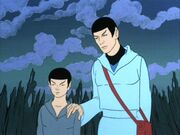
Spock, younger and elder...
"Yesteryear" is the second episode of the first season of Star Trek: The Animated Series.
Spock, Kirk, and Erickson return through the Guardian of Forever after observing the dawn of Orion civilization. McCoy expresses surprise at the new arrival with Kirk and Erickson. Back on the Enterprise, McCoy reintroduces the ship's first officer for the past five years, an Andorian named Thelin.
- "Captain's log, supplemental. When we were in the time vortex, something appears to have changed the present as we know it. No one aboard recognizes Mr. Spock. The only answer is... that the past was somehow altered."
Discovering that he had died at the age of seven and his mother soon afterward in a shuttle accident, Spock must travel back through the Guardian and try to prevent the events leading to his premature death.
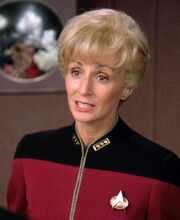
Admiral Alynna Nechayev in 2370
Alynna Nechayev was a Human Starfleet flag officer during the late-24th century. She was a significant figure in Starfleet's dealings with the Cardassian Union and a fierce advocate of Federation security. She was Captain Jean-Luc Picard's direct superior but had a poor working relationship with him.
In 2369, while serving as a vice admiral, she ordered Picard to relinquish command of the USS Enterprise-D to Captain Edward Jellico, the latter having had experience with Cardassians in the past and having worked to establish the original armistice of the Federation-Cardassian War. She assigned Picard to a special operation to infiltrate a Cardassian installation on Celtris III. After Jellico's negotiations with Gul Lemec deteriorated, she authorized his actions against the Cardassian warships in the McAllister C-5 Nebula, at the risk of provoking open war and abandoning Picard.
Nechayev was promoted to the rank of fleet admiral in the year 2370, during which time she paid another visit to the Enterprise-D. Nechayev believed that Picard was too soft-handed in his dealings with Federation adversaries. She cited in particular his refusal to use Hugh as a carrier to introduce an invasive program into the Borg Collective. When she later commanded the Starfleet task forces assembled in response to the Borg attack of 2369, she ordered Picard to deploy the program should another opportunity avail itself. Picard tried making amends in 2370, offering her Bularian canapés to help her feel welcome aboard the Enterprise. However, his objections to her order removing the Native American colonists from the Dorvan V colony in the Demilitarized Zone left tension between the two.
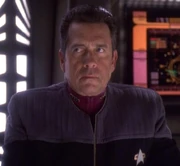
Admiral William Ross (2375)
William J. Ross was a Human male who served as a Starfleet officer in the mid- to late-24th century. As an admiral, Ross took command of military operations during the Dominion War and led the Allied forces during the Battle of Cardassia, later presiding over the signing of the Treaty of Bajor, which ended the war.
Ross was a leader of Starfleet forces during the Dominion War and coordinated his battle plans from Starbase 375. When Captain Benjamin Sisko and his crew arrived at the starbase, Ross appointed him the lead in a mission to destroy a Dominion ketracel-white facility using the Jem'Hadar attack ship they had captured a year prior. Later that year, he was present for and supported Operation Return, Captain Benjamin Sisko's plan to retake the key space station Deep Space 9.
Behind closed doors, Ross secretly aided the covert Federation organization Section 31 by helping their agents infiltrate the first Federation-Romulan conference on Romulus. Ross defended his actions by stating that he had no choice, and that while he disliked doing what he did, he also disliked ordering young women and men to die. Ross stated he felt helping the rogue organization was the best way to maintain the Federation alliance against the Dominion.
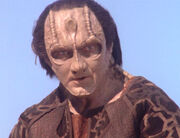
Elim Garak
Elim Garak was a Cardassian tailor and Promenade shopkeeper of Garak's Clothiers who lived on the space station Deep Space 9. Garak was a former operative in the Cardassian Obsidian Order but was exiled to Terok Nor following a fall from grace with his mentor, and father, Enabran Tain.
During his time as an operative, Garak was instrumental in the arrest and execution of Gul Dukat's father. He also spent time on Romulus, posing as a gardener at the Cardassian embassy and was rumored to have been involved in several assassinations there. Following his betrayal of Tain, Tain ordered him killed but Garak escaped and was exiled from his homeworld of Cardassia Prime.
Garak kept contacts in the Cardassian Union after his exile, and when Starfleet took control of Deep Space 9, he attempted on occasion to use his experience and his position as the only Cardassian still aboard to regain his usefulness. He was involved in the apprehension of Tahna Los, the escape of several important members Cardassian Underground in 2370, and the return of an abducted Major Kira. Garak also worked with Starfleet during the Dominion War and returned to Cardassia Prime after the Battle of Cardassia.

Thy'lek Shran in 2154
Thy'lek Shran was an Andorian commander in the Imperial Guard in the 2150s. Despite his aggressive and xenophobic background, Shran became an unlikely ally of Starfleet Captain Jonathan Archer and a proponent of strengthened ties between Andoria and Earth.
Shran first encountered Archer in June of 2151, when Shran led a raid on the Vulcan monastery at P'Jem in search of a clandestine sensor array which they believed the Vulcans were using to spy on Andorian territories. Captain Archer, along with Tucker and T'Pol, accidentally stumbled into the confrontation while on a courtesy visit to the Vulcan monks. During an ensuing firefight, an advanced subspace sensor array was discovered, proving the Andorians were right. As a gesture of peace, Archer gave Shran sensor readings and images of the facility and allowed him to leave freely.
Later that year, Shran was assigned to an Andorian covert ops unit supporting an uprising on Coridan. To repay his debt to Archer from their first encounter, he assisted in Archer and T'Pol's escape from the planet after they were imprisoned as rebels. In 2152, Shran was commanding ground forces deployed to Weytahn, where Vulcan and Andorian commandos had been fighting for control of the planet. Shran sought to negotiate a truce with Vulcan ambassador Soval and requested Captain Archer serve as mediator. The negotiations were ultimately successful and a cease fire was arranged.

Dr. Katherine Pulaski in 2365
Commander Katherine Pulaski, MD, was the chief medical officer aboard the USS Enterprise-D in 2365 while Dr. Beverly Crusher was serving as head of Starfleet Medical.
Prior to her posting to the Enterprise, Pulaski served as chief medical officer on the USS Repulse under the command of Captain Taggert. Like her predecessor eighty years before, Dr. Leonard McCoy, Dr. Pulaski had a transporter phobia. She rarely used the transporter while posted to that vessel, preferring to use shuttlecraft whenever possible. Taggert was fond of Pulaski, and said he would have given her a personal shuttlecraft if she had agreed to remain aboard the Repulse.
By 2365, when she transferred to the Enterprise, Pulaski carried the rank of commander, but unlike Dr. Crusher, she was not considered a bridge officer. Early in her career, Pulaski authored a groundbreaking research paper called "Linear Models of Viral Propagation". It was still the standard on the subject in 2365. She also performed two successful operations involving ocular implants, and offered the procedure to Lieutenant Geordi La Forge, although he turned down the opportunity.
Dr. Crusher decided to return to the Enterprise in 2366. Pulaski transferred off the ship sometime prior to Crusher's return.
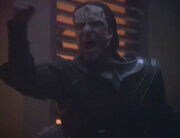
Damar rallying support on Cardassia against the Dominion in 2375
The Cardassian Liberation Front, also known as the Cardassian Rebellion, was a popular uprising led by Legate Damar against the occupation of the Cardassian Union by the Dominion in 2375.
Although the revolt had little military impact and was quickly crushed by the Jem'Hadar, the uprising nonetheless had a great effect on the outcome of the Dominion War by forcing the Dominion to divert resources to quelling the rebellion, just as they were poised to launch a massive assault against the Federation, Klingons, and Romulans. Ultimately, the rebellion allowed the allies to win the war at the Battle of Cardassia, although their actions would have devastating consequences for Cardassia Prime.
By 2375, the Dominion's war effort against the Federation Alliance was settling into a bloody stalemate, with the tide steadily turning in the latter's favor. Damar, as leader of Cardassia, was becoming ever more frustrated with his Dominion allies, who had promised to return Cardassia to greatness but instead seemed intent on merely using Cardassia's resources to wage their war against the Federation and its allies. Initially, Damar tried to avoid his self-doubt by drinking excessive amounts of kanar and shirking many of his duties.
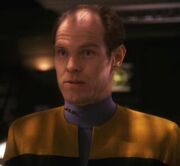
Michael Eddington in 2372
Michael Eddington was a Starfleet security officer assigned to station Deep Space 9. Eddington became disillusioned with Starfleet and the Federation, and joined the Maquis. He was captured, but was killed during a special operation while serving his sentence. Eddington was born in Canada.
Eddington was stationed to DS9 in 2371 after first contact with the Dominion. This was done in part to increase Starfleet control of the station's security operations, as Starfleet did not have full confidence in the current security chief, Odo.
In late 2372, Eddington defected to the Maquis rebels by using his position within Starfleet to hijack a shipment of class-four industrial replicators headed to the Cardassian Union from the Federation. He diverted the attention of Captain Sisko by raising suspicions about the business activities of Kasidy Yates, who was involved in supplying the Maquis with non-military supplies during meetings in the Badlands. By the time the USS Defiant returned from the Badlands, Eddington and the replicators had disappeared into Maquis territory.
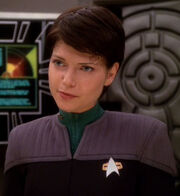
Ezri Dax
Ezri Dax, formerly Ezri Tigan, was a joined Trill, the ninth host of the Dax symbiont and served as counselor aboard Deep Space 9, beginning in 2375. After the previous host of the Dax symbiont, Jadzia Dax, had died, the Dax symbiont was rushed to Trill on the starship USS Destiny. On the Destiny the symbiont's status deteriorated and Ezri, as the only unjoined Trill on the ship, had to undergo the procedure of joining.
Following the joining, Ezri returned to Trill with the Destiny, and met with members of the Symbiosis Commission's Evaluation Board, who gave her counseling on how to deal with her new memories, but they were unable to help her further. With her friends and family having difficulty adjusting to her changed personality, and her own confusions about who she really was, Ezri took a leave of absence. She traveled to Earth and met a friend of the two previous hosts, Benjamin Sisko. Together with him, she uncovered the Orb of the Emissary, and restored the Prophets to the Celestial Temple.
She then took a commission on Deep Space 9 as counselor and remained there for the rest of the Dominion War.
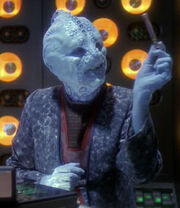
Grathon Tolar
Grathon Tolar was a skilled holographic forgery artist and con man.
In 2374, Tolar was awaiting execution in a Klingon prison for unspecified crimes. Benjamin Sisko contacted Chancellor Gowron to arrange a pardon for Tolar. Under the conditions of the pardon, Tolar had to create a holo-program for Sisko. The program was a faux recording of a high-level Dominion meeting in which the supposed plan for the invasion of Romulus was discussed.
Before Tolar could complete it, he was involved in an altercation at Quark's. Sisko was forced to bribe Quark in order to have the charges dropped. When he did finish it, the recording did not fool Romulan senator Vreenak. Vreenak took the evidence intending to return to Romulus, but his shuttle exploded on the way from a bomb placed there by Elim Garak. Garak then killed Tolar so there would be no witnesses to the operation.
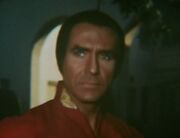
Khan Noonien Singh as he appeared in 1996
Khan Noonien Singh, or simply Khan, was a genetically-engineered Human and the most prominent tyrant of the late-20th century Eugenics Wars on Earth. Khan reappeared with a cadre of Augment followers in the 23rd century and became a notorious enemy of James T. Kirk.
Records of the period, including Khan's origins, are vague. He was the product of a secret selective-breeding and genetic engineering program, based on the eugenic philosophy that held improving the capabilities of a man improved the entire Human race. Augments produced by the program possessed physical strength and analytical capabilities superior to ordinary Humans, and were created from a variety of Earth's ethnic groups. Khan's background was suspected to be Sikh, from the northern region of India.

Bajor in shambles just after the end of the Cardassian occupation in 2369
Stretching back hundreds of thousands of years, recorded Bajoran history tells the story of a spiritual people trying to find their place among larger forces.
Half a million years ago, Bajorans were renowned for their accomplishments in science, mathematics, philosophy, and the arts. 10,000 years ago, orb-like artifacts called Tears of the Prophets first appeared on Bajor, ushering in a new era of spiritual connection between the Prophets on the one hand, non-corporeal beings living in a nearby wormhole to the Gamma Quadrant, and the Bajorans on the other hand, who created an entire religion around them. By the 16th century, Bajoran explorers used lightships to travel through their star system, where they stumbled upon tachyon eddies that propelled them all the way to the neighboring Cardassian system. Around 2319, the most dramatic episode in Bajoran history began, when the Cardassian Union started its occupation of Bajor. Many atrocities committed against the land and the people caused a fierce resistance movement to form, which eventually drove the Cardassians off in 2369. Despite several isolationist voices, the new Provisional Government of Bajor immediately sought out assistance and protection by the Federation. Bajor's planned accession to the Federation in 2373 was delayed, however, which permitted the planet to remain neutral when open war broke out between the Federation-Klingon alliance and a hegemonic power from the Gamma Quadrant called Dominion. While ongoing schemes to gain more power by Bajor's religious leader, Kai Winn Adami, finally led to her death, the Dominion was eventually defeated and the Treaty of Bajor formally ended the conflict.
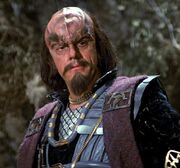
Kruge
Commander Kruge was a male Klingon officer of the 23rd century Klingon Empire. In 2285, he commanded a Klingon Bird-of-Prey. He was romantically involved with Valkris and kept a Klingon monster dog as a pet.
In 2285, Kruge played a major role in a plot to obtain intelligence on the Genesis Device, a Federation technology designed to instantly terraform an entire planet. He saw it as an incredibly powerful weapon, and sought to bring that technology to the Empire. He recruited Valkris as a spy to obtain material from the project, and once successful, she made a rendezvous with Kruge on the Merchantman. When he learned from her that she had viewed the material even though she was not to have done so, however, he destroyed the vessel without beaming her aboard.
Kruge, now with the project summary in hand, ordered a course set for the Genesis Planet, which had only recently been formed. Arriving at that destination, he and his crew encountered the USS Grissom, a Federation science vessel assigned to study the planet. Kruge wanted to gain hostages with which to bargain for the Genesis technology, so he ordered his gunner to target the Grissom's engines in order to disable the vessel. However, in what the gunner described as a "lucky shot," the Grissom was destroyed. Kruge responded by instantly killing the gunner. After Torg found that a landing party from the Grissom had survived on the planet's surface, Kruge led a team to search for them.
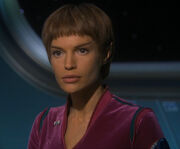
T'Pol in 2154
T'Pol was a Vulcan who served aboard Enterprise NX-01 in the mid-22nd century. She was the first Vulcan to serve aboard a Human ship for any substantial period.
The Vulcan High Command assigned Sub-Commander T'Pol to the United Earth Starfleet vessel Enterprise in April 2151 following Earth's accidental first contact with the Klingon courier Klaang. She acted as "chaperone", in exchange for the Vulcan star charts and Klingon linguistic database, and was not immediately accepted by the Human crew. The ship's Chief Engineer, Commander Charles Tucker III, referred to T'Pol as a "spy". Despite the crew's misgivings, she was instrumental in uncovering a plot by the Suliban Cabal to destabilize the Klingon Empire. T'Pol was persuaded by Captain Archer to remain aboard following the successful conclusion of the mission to return Klaang to his people, instead of returning to the Vulcan Consulate in San Francisco.
Following the Xindi attack on Earth on April 24, 2153, Enterprise was recalled home and underwent a major refit in preparation for a mission into the Delphic Expanse. Since this mission was seen by the Vulcan High Command as being an Earth matter, Ambassador Soval ordered T'Pol to return to Vulcan to be reassigned to the Ministry of Information. It was expected that, after a brief time at the Ministry, she would be allowed to return to Earth to continue her diplomatic duties. However, T'Pol resisted. As Enterprise set course for Vulcan to deliver T'Pol home and proceed to the Expanse, she abruptly resigned her commission and chose to remain aboard.
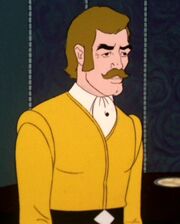
A Vendorian posing as Carter Winston
Carter Winston was the alias assumed by a Vendorian as part of a subterfuge plot. Prior to assuming this false identity, this Vendorian tended to the real Carter Winston after his trading vessel crash landed on the planet Vendor, until Winston's death almost a year later in 2265.
In 2269, this Vendorian began working for the Romulans, in the guise of Carter Winston. As part of the ruse, the impostor set Winston's craft adrift near the Romulan Neutral Zone, where it was eventually discovered by the USS Enterprise.
After successfully convincing the crew he was Winston by producing the Human's identity tape and undergoing an examination by Doctor McCoy, he "reunited" with Winston's fiancée, Anne Nored, telling her that he'd changed and couldn't ever marry her.

Ensign Melora Pazlar
Melora Pazlar was a 24th century Elaysian Starfleet officer. She was the first of her species to enter Starfleet and specialized in the field of stellar cartography.
Being from a species native to a low-gravity planet, it was extremely difficult for Melora Pazlar to function in "standard" gravity. As a result of this limitation, only a small number of her kind actually left the Elaysian homeworld to explore space.
The limitation she experienced did not stop her, however, and she soon enlisted in Starfleet. Part of her reasoning for joining Starfleet was to encourage others and show them that she could overcome any adversity; however, she also had a strong desire to explore space and other worlds, instead of merely being confined to her planet.
At some point in her life, she learned to speak Klingonese to a fluent level and developed an interest in Vulcan music such as etudes by Delvok. She also enjoyed Klingon food, preferring to see "the blood running through the veins" of her racht.
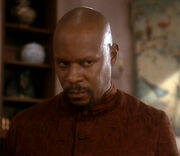
Hippocrates Noah
Hippocrates Noah was a holosuite character created for Julian Bashir's Secret Agent holographic program revolving around the espionage of Earth's nation-states during the Cold War of the 20th century. His henchmen included Falcon and Duchamps.
In 2372, Bashir was running the holo-program when the USS Orinoco was destroyed by a warp core breach during its return to Deep Space 9. The explosion of the runabout caused a massive power feedback in the station's power grid through the transporters, shutting down all but emergency power and forcing station personnel to store the transporter patterns of the runabout crew in the memory banks of the holosuite as an emergency measure. The result was that characters in the holographic program took on the physical characteristics of the crew of the runabout, including Benjamin Sisko, whose image replaced that of Noah.
In the context of the program, Noah was an "evil genius" who believed the decadence of the world had led to such a chaotic situation that a new beginning was necessary. He intended to kill all of Earth's population, save for those at his mountain retreat on the slope of Mount Everest (the highest point on the planet), where he had gathered the most brilliant scientists and artists from around the world. Strategically positioning powerful lasers at various locations, Noah planned to use them on the surface, producing massive fissures in the Earth's crust that would release millions of tons of molten lava. The end result would be a significant reduction in the surface area of the planet – "like letting air out of a balloon," as he described it – causing massive flooding. Noah's plan was foiled by Bashir with help from Honey Bare, who had taken the form of Jadzia Dax, and Elim Garak. Bashir's companion Anastasia Komananov (replaced by the image of Kira Nerys) wanted to kill Noah, but Bashir stopped her, fearing the holosuite would erase Sisko's image.
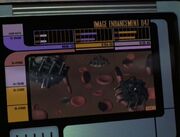
Assimilation in progress: Borg nanoprobes assimilate blood cells
Assimilation was the process by which the Borg added new members and new technology to the Collective.
Borg assimilation was predatory; every species the Borg encountered was assessed to determine whether its biological and/or technological distinctiveness was considered "worthy of being added to the Collective's perfection". If found to be so, the species was set upon and forcibly assimilated; the Collective considered the species' will in the matter "irrelevant". As of the 24th century, the only species known to have been considered unworthy of assimilation were the Kazon.
The Borg generally did not assimilate individuals, and instead preferred to target larger groups such as the crews of starships and the populations of planets. When in the presence of a small number of individuals, Borg drones would ignore them altogether. This policy would remain in effect until an individual demonstrated some quality found worthy by the Collective, or posed a threat to Borg activities. For example, when the USS Raven was first detected by a Borg vessel it was disregarded. By the time the Raven was detected a second time, its crew had developed technologies to elude Borg sensors, making them a more worthy target.

Christoper Lloyd
Christopher Lloyd played the role of Klingon Commander Kruge in the 1984 film Star Trek III: The Search for Spock. He is perhaps best recognized for his roles on the television series Taxi and the successful Back to the Future films.
Born in Stamford, Connecticut, Lloyd attended the prestigious Fessenden School in Massachusetts and later Staples High School in Connecticut, graduating from the latter in 1957. Since embarking on a career in acting, he has appeared in over a hundred film and television projects as well as over 200 stage productions, and has become a highly recognized figure in show business.
Lloyd first rose to fame as Reverend Jim Ignatowski on the ABC (and later NBC) television comedy Taxi. Lloyd won two Emmy Awards for his role as the lovable, burnt-out Ignatowski, one in 1982 and another in 1983. Coincidentally (as revealed in the episode "Jim Joins the Network"), Lloyd's character was a huge fan of Star Trek who resented NBC's decision to cancel the show. However, one of the character's qualms about the series was the male Romulan commander (in "Balance of Terror"), whom he believed "did things no Romulan would ever do."
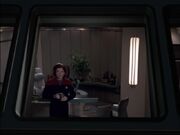
Captain Janeway looks out into space from her ready room
"Good Shepherd" was the twentieth episode of the sixth season of Star Trek: Voyager.
Captain Janeway looks out her ready room window into space as her door chirps. Chakotay enters and informs her that Seven of Nine wants to present her ship-wide efficiency report to the senior staff. Janeway says to put her on the schedule. Chakotay also reminds her that they'll be passing through a class-T cluster in the next couple of days, not important enough to alter course, but Janeway thinks it's at least important enough to send out the Delta Flyer and to get a full range of scans. Chakotay nods, and leaves.
On the bridge, Chakotay relays the captain's orders. He tells Tom Paris to prepare the Delta Flyer for the mission, and Harry Kim to do a level 3 analysis of the cluster. Harry Kim contacts Seven, asking her to increase metagenic resolution in the long-range sensors.
In astrometrics, Seven and Crewman Tal Celes, a young Bajoran woman, are working on the sensors. Seven types some data into a PADD and hands it to Celes, telling her to take it to Lieutenant Torres. Celes exits, and walks down the corridors to a turbolift. "Deck 11", Celes tells the computer as the turbolift begins whirring.
=== Hawk (Lieutenant) ===
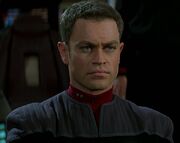
Lieutenant Hawk
Hawk was a Human male who served as conn officer on the USS Enterprise-E in 2373. In that capacity, he served on the bridge of the ship during the Battle of Sector 001.
Although the invading Borg cube was eventually destroyed by a fleet of Starfleet vessels, one Borg sphere managed to escape on a direct heading towards Earth. Hawk piloted the Enterprise in pursuit of the sphere which subsequently created a temporal vortex through the controlled emission of chronometric particles. On the instruction of his captain, Hawk piloted the ship into the vortex where it emerged in the year 2063.
The Borg's plan was quickly realized - to go back in time and assimilate Humanity when it was vulnerable. The Enterprise was able to destroy the Borg sphere but not before a group of drones was able to beam aboard the ship and begin efforts to construct an interplexing beacon with which to contact the Borg of that era.
Together with Captain Jean-Luc Picard and Lieutenant Commander Worf, Hawk went out onto the ship's hull to stop the Borg from modifying the Enterprise's deflector into a beacon. During the fight, Hawk was pulled over the side of the ship and assimilated. Now a drone, he set about trying to stop his former colleagues but was ultimately killed by Worf.

A security force field in 2364
A force field was an energy barrier with many applications and varying degrees of strength. Although force fields had been in use for many years, Starfleet did not begin research on such a device until 2147, then referred to by Malcolm Reed as a "stable EM barrier." By the 24th century, Starfleet force fields were commonplace and were rated by intensity, ranging in strength from level 1-10. A level 10 force field was the strongest, and would be used, for example, during a scientific experiment of which the outcome was unknown, or known to be explosive in nature. Applications range from creating holograms, to sealing a hull breach, to personal force fields designed to keep potential assailants at bay.
The effects of a force field on its surroundings varied greatly. Contact with a force field could cause anything from a slight tingle to death. Most force fields were non-lethal, although some civilizations, such as the Dominion, preferred the lethal variety. If a force field was active, an object or transporter beam generally could not pass through it.

Guy Vardaman
Guy Vardaman is a stand-in performer who often appeared in the role of Darien Wallace on Star Trek: The Next Generation. He also served as photo double for Data during the majority of the show's run, from the first season's "The Big Goodbye" through the final episode, as well as for Star Trek Generations. Additionally, he was a Research Consultant for the show's creator, Gene Roddenberry.
Hailing from Glendale, California, Vardaman spent a good part of his life in San Jose. He grew up watching Star Trek: The Original Series, becoming a huge fan of the series. He never dreamed that he would become a part of the Star Trek universe himself.
To support himself while he was in school, Vardaman joined the Screen Extras Guild to acquire a part-time job. Less than two weeks later, while signing up with casting, he was spotted and approached for a job on Star Trek: The Next Generation. As it turns out, the man originally approached for the job was unavailable, prompting the need for a replacement. Despite some initial reluctance from the wardrobe department, Vardaman was fitted with an operations yellow Starfleet uniform and reported for work the following day.

Picard surrounded by the Borg
Star Trek: First Contact was the eighth motion picture in the Star Trek film franchise and the second film staring the cast of Star Trek: The Next Generation.
Still haunted by memories of his assimilation, Captain Jean-Luc Picard awakes from a nightmare to a communiqué from Starfleet Command. Appearing on his desktop terminal, Starfleet Admiral Hayes relays distressing news: a Borg cube has attacked a Federation outpost and crossed into Federation space.
Picard dutifully informs his crew that they are to take the new USS Enterprise-E to the Romulan Neutral Zone, a minor threat compared to the Borg. The senior crew protest and are confused as to why the most advanced ship in the fleet is relegated to a relatively unimportant task. Picard doesn't disagree with the protests but is compelled to follow orders. He later confides to First Officer William T. Riker that the reason Starfleet is keeping the Enterprise away from the Borg is due to Picard's history with them. Riker emphatically disagrees with Starfleet's decision, saying that Picard's experience with the Borg would be a valuable asset in fighting them. They then receive word that the fleet has engaged the Borg and listen as the battle appears to go badly for the fleet.

Selection of models and related merchandise
Star Trek: The Official Starships Collection is a British partwork magazine that is published by Eaglemoss Collections under its Hero Collector imprint. Authorized and licensed by CBS Consumer Products, it is available in a number of countries worldwide.
The default product is a model starship made of die-cast and plastic, shipped with a magazine elaborating on the ship's in-universe appearance, design process, and Behind-the-Scenes material from all ranges of Star Trek productions.
Besides the main line of fortnightly released issues, The Official Starships Collection offers specials, bonus editions, and XL editions of various models, bringing life to rejected concepts such as the Narendra-class USS Enterprise-C, and Expanded Universe creations like the USS Aventine from Pocket Books.
The collection's successful run has let to spin-off lines focused on Star Trek: Discovery and Star Trek Online.
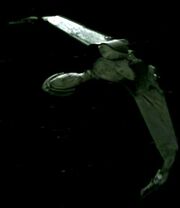
The IKS Rotarran
The IKS Rotarran was a Klingon Bird-of-Prey in service during the 2370s.
With the withdrawal of Klingon fleet from Cardassian space in mid-2373, following the Cardassian's successful admittance into the Dominion, the Rotarran suffered half a dozen successive defeats in combat with the Jem'Hadar, mounting heavy casualties over a period of seven months.
Late that year, General Martok was assigned command of the Rotarran by the Klingon High Council and dispatched to locate the missing IKS B'Moth. Joining him was Worf as his first officer and Jadzia Dax as science officer; both serving on detached duty from Starfleet.
Plotting course for the last known position of the B'Moth, the Rotarran was forced to circumnavigate the Tong Beak Nebula in order to avoid the Jem'Hadar. Martok's wish to avoid a fight struck a sour chord with his weary crew.
On the way, Martok reviewed his crew's personnel reports, which included remarks such as: "dishonorable conduct," "lack of respect," "dereliction of duty," "inattention to orders," "unmotivated," and "insufficiently aggressive." This did not go over well with neither Martok nor Worf. Together they vowed to restore honor to the Rotarran and make it a ship worthy of the Empire.

The Defiant
The USS Defiant (NX-74205) was the second Federation starship to bear the name, and the prototype of the Defiant-class of starships.
The Defiant had been first designed in 2366 as a new ship to fight the threat of the Borg, although it was officially designated as an escort vessel. The ship had been built but the receding Borg threat, numerous flaws, and the fact that it almost tore itself apart during test cruises convinced Starfleet to put the project on hold. Benjamin Sisko became involved in the project when he transferred to the Utopia Planitia Fleet Yards shortly after the destruction of the USS Saratoga at Wolf 359.
The Defiant was assigned to Deep Space 9 in 2371 and was immediately put to the test when it entered the Gamma Quadrant on a mission to open negotiations with the Founders of the Dominion. The starship came under attack by several Jem'Hadar ships and was boarded. Its crew was held and eventually released but its first encounter with the Dominion would not be its last. The Defiant remained at DS9 and saw extensive action during the Federation-Klingon War and the Dominion War.
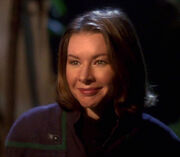
Cutler
Cutler was a crewmember and an entomologist assigned to the Enterprise NX-01 in the early 2150s.
In 2151, Cutler participated in her first away mission when T'Pol requested her assistance on the planet that became Archer IV. While on the planet, Cutler was exposed to tropolisine, but fortunately for her, was not psychologically affected by the compound before being successfully treated by Dr. Phlox. Later that year, as part of her training as a medic, Cutler accompanied Phlox to the planet Valakis to assist in treatment of the Valakians. The two studied the differences between the Valakians and the Menk.
In February 2152, Cutler assisted in the initiation of Phlox's yearly hibernation requirement while the crew partook of shore leave in orbit of Risa. She acted as chief medical officer for a time, but was unable to treat Travis Mayweather, and Phlox had to be awoken to assist.
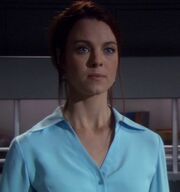
Gannet
Gannet was a Human news reporter who lived on the planet Earth in the mid-2150s.
In 2155, Gannet provided news coverage of a conference on Earth whose goal was the establishment of a Coalition of Planets. During this period she came aboard the Enterprise, where the crew later discovered that she had reconfigured her universal translator at the conference on Earth to record messages from all the other translators and had been spying on the delegates there. Most of the Starfleet officers suspected that Gannet was a member of the xenophobic organization Terra Prime. However, Ensign Mayweather believed that Gannet may have simply been doing undercover research for a news report.
Gannet later revealed that she was actually working for Starfleet Intelligence, not Terra Prime. In an attempt to explain why she had not revealed her true mission earlier, Gannet said that she was aware that a Terra Prime agent could possibly be operating on board Enterprise. Her own identity would have been compromised if she had attempted to contact the head of her division.
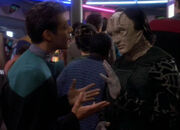
Bashir and Garak wait in line
"The Wire" is the 22nd episode of the second season of Star Trek: Deep Space Nine.
As Garak and Julian Bashir wait in line at the Replimat on the Promenade, they discuss a book Garak loaned the doctor, The Never Ending Sacrifice. Garak describes it as the finest Cardassian novel ever written, though Bashir reluctantly admits he found it dull in parts. Bashir notes that the plot involves seven generations of a family, yet all of the characters spend their lives serving the state. Garak finds this to be a redeeming quality, as the repetitive epic is the most elegant form of Cardassian literature. When Bashir points out that there is more to life than duty to the state, Garak calls him a prisoner of "Federation dogma and Human prejudice."
Bashir seems hurt by Garak's harsh comment, and as he responds, Garak suffers a severe and sudden migraine. Although Garak insists he is fine, Bashir points out that his skin is clammy and his pupils have contracted. Garak claims to be in perfect health and attempts to return to the topic at hand but he is again interrupted by another bout of pain. Bashir rhetorically observes that Cardassian standards must be lower than his own and begins to lead Garak to the infirmary, but Garak refuses to go with him, believing there is nothing wrong that sleep will not cure. He claims to have lost his appetite and walks off, agitated. Major Kira observes Garak's sudden departure and curiously walks over to Bashir to ask what happened, but the doctor is just as confused as she is...
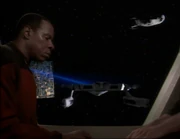
Sisko leaves the Saratoga
"Emissary" is the premiere episode of Star Trek: Deep Space Nine.
Lieutenant Commander Benjamin Sisko is first officer aboard the USS Saratoga while it battles the Borg led by Locutus, the former Captain Jean Luc Picard, at Wolf 359. When the ship takes a direct hit, which kills most of the bridge crew and causes the start of a warp core breach, Sisko helps civilians get to the escape pods. In the crew quarters he finds his son, Jake, buried under a pile of rubble, but Sisko manages to free him. Sisko also tries to save his wife Jennifer, but she has already been crushed to death by the falling debris. Despite this, Sisko still tries to free her body in vain, and is ultimately dragged away by a crew member to an escape pod. Together with Jake and other survivors, Benjamin flees the doomed Saratoga moments before the ship explodes.
- Stardate 46379.1: Three Years Later
Commander Benjamin Sisko approaches Jake, now a teenager, who is fishing in a lake. Jake asks his father questions about the Cardassian space station they're going to and why they can't just live on Bajor, the planet the station orbits. Commander Sisko assures Jake that he will have fun and meet lots of new friends, but they are interrupted by a voice from the bridge, informing Sisko that they are approaching Deep Space 9...
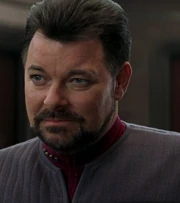
Captain Will Riker in 2379
William Thomas Riker was a noted Starfleet officer, perhaps best known for his long assignment as first officer under Captain Jean-Luc Picard aboard the USS Enterprise-D, and later the USS Enterprise-E. In 2379, he finally accepted a promotion as captain of the USS Titan.
During the course of his career, Riker served on a number of other ships, including the USS Pegasus, Potemkin, and Hood as well as the IKS Pagh. He was known to have turned down the commands of the USS Drake, Aries, and Melbourne by the end of 2366, and Q once said that he "was betting Riker" would have taken command of the USS Voyager before its launch in 2371. Riker also temporarily captained a number of vessels before the taking command of the Titan, most notably the USS Hathaway, Excalibur, and the Enterprise-D, when he was field promoted during the Borg crisis in late 2366, though he chose to return to the rank of commander and remain first officer on the Enterprise when the crisis ended in early 2367. He expressed disappointed that he would never have the chance to command the Enterprise-D again when the ship was destroyed in 2371.
Unknown to history until 2373, Riker and Geordi La Forge flew on the Phoenix, Humanity's first warp flight, with Zephram Cochrane in 2063, during a temporal incursion by the Borg collective in an attempt to disrupt First Contact between Humanity and the Vulcans.
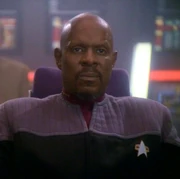
Benjamin Lafayette Sisko
Benjamin Lafayette Sisko was a famous Starfleet officer best remembered for his seven-year assignment commanding station Deep Space 9 in the Bajor sector. After discovering the Bajoran wormhole, he became known to the Bajoran people as the Emissary of the Prophets. He fought the Borg at the Battle of Wolf 359 and was a key player in the Dominion War.
Sisko was born in 2332 in New Orleans, Earth. His mother had been possessed by a Prophet – a non-linear alien species which lived in the then-undiscovered Bajoran wormhole. The Prophet had used Sarah Sisko to ensure that Benjamin would be born and take his rightful place as Emissary of the Prophets.
Sisko met his future wife, Jennifer, soon after graduating from Starfleet Academy in 2354. The two produced a son, Jake. Tragically, Jennifer was killed at Wolf 359 in 2367. Three years later, Sisko was assigned to command Deep Space 9, with he and his son residing on the Cardassian-built space station. Although he intended to resign from Starfleet at this point, his subsequent encounter with the Prophets allowed him to let go of the past and remain aboard Deep Space 9 to fulfill his duty – and his destiny.
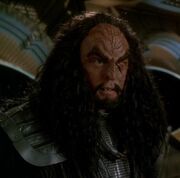
Martok in 2375
Martok was a Klingon warrior who rose to the rank of general in the Klingon Defense Forces and later became Chancellor of the Klingon High Council. His brilliant leadership during the Dominion War made him very popular both among other warriors and among the civilian population. As the leader of the House of Martok, he became a good friend of Worf while the two were stationed together on Deep Space 9.
Martok was born in the lowlands of the Ketha Province on Qo'noS to a common family. Fifteen generations of Martok's family had served the Empire as warriors, but Martok's father had hopes that Martok could become an officer. It took some doing, but Martok was able to take the entrance exam and passed. After getting the "stamp of Kor" for lacking noble blood, Martok was reduced to a civilian laborer. During a battle with the Romulans while serving on ShiVang's flagship, Martok's ship was boarded. Martok acquitted himself so well in the fighting that he earned a battlefield commission. He worked his way up and rose in ranks until finally achieving the rank of general.
Some time in 2371, Martok was replaced by a Changeling. His whereabouts were unknown until he was rescued from Internment Camp 371 in 2373. Late that year, Martok was given his first field assignment following his imprisonment – command of the IKS Rotarran, and later, command over the Ninth Fleet.
After Chancellor Gowron had taken command over the Klingon forces, Worf challenged him in a battle to the death, for dishonoring the Empire and the Klingon soldiers. When Worf killed Gowron, Worf gave the title of Chancellor to Martok.
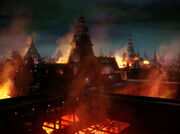
Qo'noS burns during the Civil War
The Klingon Civil War was a conflict fought in early 2368 over the right to choose the next Chancellor of the Klingon High Council and de facto leader of the Klingon Empire. The war was fought between forces loyal to Gowron, the legally appointed candidate, and the supporters of the House of Duras, led by Lursa and B'Etor. The war was a decisive victory for Gowron, but it was achieved only through indirect assistance from the United Federation of Planets in exposing covert Romulan assistance to the forces of the Duras family.
The conflict had its roots in the reign of K'mpec, the longest-lived chancellor of the Empire. Although K'mpec ruled with an iron fist and managed to keep peace within the Empire, his influence began to wane as he grew older, and two opposing factions began to develop. The first faction, led by Gowron, favored the continuing alliance with the Federation, while the second faction, led by Duras, sought to establish a more independent and aggressive policy for the Empire. Duras had support from a large majority of the High Council, while Gowron's support came largely from political outsiders and military personnel.
Tensions came to a head in early 2367 with the sudden revelation that K'mpec was dying. He had been slowly poisoned by Veridium Six that had been introduced into his bloodwine. Because the killer had not shown his face to his victim, Klingon tradition considered the act to be without honor. Recognizing the corruption that had taken hold in the Empire, K'mpec decided that he could not trust any Klingon with the task of choosing the next leader of the Empire. Therefore, he took the unheard-of action of selecting Jean-Luc Picard, a Human Starfleet officer, as the Arbiter of Succession.
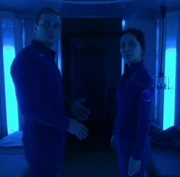
Commander Tucker and Ensign Sato under Organian control
The Organians were a race of powerful non-corporeal beings that live on the planet Organia. Organians were once corporeal, but they eventually evolved a non-corporeal form. They implied that their desire to avoid physical pain was a reason for that.
For ten thousand years, they observed a planet that contained a silicon-based virus, and the reactions of species that encountered it, in an attempt to find a species with a higher level of intelligence. Among the species which the Organians observed as they attempted to deal with this deadly virus were the Klingons, Cardassians, and Humans.
In 2154, Enterprise NX-01 investigated a Klingon waste site on the planet, and a landing party consisting of Commander Charles Tucker III and Ensign Hoshi Sato contracted the virus. Following their protocol of non-interference, two Organian observers watched the crew's reaction to the situation by inhabiting the bodies of crew members, and subsequently altering their memories so that they had no recollection of the Organians' actions. One of the two observers, apparently the more senior of the two, felt that the Organians' protocols should be followed strictly; the other, who was impressed by the Humans' compassion, felt that the time had come for the protocols to be altered. The junior observer argued that intelligence alone was not a sufficient measure of a species' worthiness to be contacted. The senior observer routinely occupied the body of Lieutenant Malcolm Reed, while his associate occupied the body of Ensign Travis Mayweather, though all of the senior staff of Enterprise were possessed by the observers at one point or another.

The USS Excelsior, the class's lead ship
The Excelsior-class was a type of Federation starship used by Starfleet from the late 23rd century through the late 24th century. It was the backbone of Starfleet for nearly a century, making it one of the longest serving starship designs, and one of the most recognizable ships in the fleet.
The Excelsior-class was initially constructed during the early 2280s at Starfleet's San Francisco Fleet Yards orbiting Earth.
Starfleet had high hopes for the first ship of this class, the prototype USS Excelsior, which was equipped with a transwarp drive, and was regarded as that century's "Great Experiment."
Despite the failure of the "Great Experiment," Starfleet forged ahead with employing the Excelsior design. After remaining in the Earth Spacedock until at least 2287, the prototype Excelsior was subsequently recommissioned for active service by 2290.
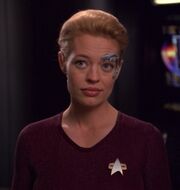
Seven of Nine in 2378
Seven of Nine (full Borg designation: Seven of Nine, Tertiary Adjunct of Unimatrix 01) was a Human female who was a former Borg drone. She was born Annika Hansen on stardate 25479 (2350), and was assimilated by the Borg in 2356 at age six, along with her parents. Liberated by the crew of the USS Voyager in 2374, she joined the crew and returned to the Alpha Quadrant with the starship in 2378.
Annika's parents, Magnus and Erin Hansen, were exobiologists investigating the existence of the Borg. After a great deal of persuasion, the Federation granted the Hansens the use of the USS Raven, a small long range craft, to aid them in their investigation. In 2353, they took Annika, then aged four, along with them. They spent a good deal of time aboard the Raven in search of the Borg; Annika celebrated three birthdays aboard the ship. Eventually, the Hansens encountered a Borg cube and followed it through its transwarp conduit into the Delta Quadrant, the Borg's region of origin. They gathered a great deal of scientific data on the biology of Borg drones and the nature of the Collective by moving undetected through Borg space due to multi-adaptive shielding, invented by Magnus Hansen. They even went aboard Borg vessels, using bio-dampeners to remain undetected. However, their research came to an abrupt end in 2356 when an ion storm struck the Raven. The ship sustained damage, including, most importantly, damage to the multi-adaptive shielding, which went off-line for 13.2 seconds. This left them exposed long enough for the Borg to detect them and perceive them as a target for assimilation. The Hansens tried to evade pursuit by masking the Raven's warp trail, but the Borg still managed to pursue and find them. They and their daughter were promptly captured and assimilated.
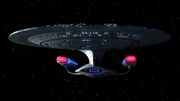
The USS Enterprise-D
The USS Enterprise (NCC-1701-D) was a Federation Galaxy-class explorer that was in service with Starfleet in the mid-24th century. This was the fifth Federation starship to bear the name Enterprise. During her career, the Enterprise served as the Federation flagship.
The Enterprise was built at Utopia Planitia Fleet Yards orbiting Mars in the Sol system. Construction was supervised by Commander Orfil Quinteros. Dr. Leah Brahms was responsible for much of the Enterprise's warp propulsion system design. Some of the Enterprise's components were derived from technology originally developed on the USS Pegasus.
On stardate 40759.5, in the year 2363, the Enterprise was launched from Mars. A year later, on stardate 41025.5, the Enterprise was commissioned.
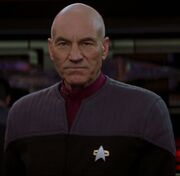
Captain Jean-Luc Picard
Jean-Luc Picard was one of the most celebrated and well-respected officers to have served in Starfleet in a career spanning over fifty years during the mid-24th century.
The highlights of his career are his positions as commanding officer of the following Federation starships: first, the USS Stargazer, followed by the USS Enterprise-D, and then the USS Enterprise-E.
In these roles, Picard not only witnessed the major turning points of recent galactic history, but played a key role in them also, from making First Contact as captain of the Federation's flagship with no fewer than 27 alien species, including the Ferengi and the Borg, as well as becoming the chief contact point with the Q Continuum, to serving as Arbiter of Succession, choosing the former leader of the Klingon Empire, Chancellor Gowron, and exposing the Romulan Star Empire as backers of his chief rivals, later aiding an underground movement of dissidents to gain a toehold on the Romulan homeworld.
He continued to serve as captain of the Enterprise-E, the sixth starship to bear the name, until at least 2379.

The Excelsior
The USS Excelsior (NX-2000, later NCC-2000) was a Federation Excelsior-class starship that was in service with Starfleet from the late 23rd century. Excelsior was the prototype for her class of starship.
Dubbed "The Great Experiment," the Excelsior was conceived during the early 2280s as the first Starfleet vessel equipped with transwarp drive. An awe-inspiring concept to some, traditional engineers were more skeptical, as in the case of Montgomery Scott, who expressed his doubt in transwarp technology with the analogy, "and if my grandmother had wheels, she'd be a wagon."
Designed under radically new principles of propulsion, the Excelsior had the potential for becoming the fastest starship in the entire Federation, as at that time, the Starfleet record for faster-than-light travel was warp factor 14.1, set by the USS Enterprise in 2269.

The Constitution-class USS Enterprise in 2254
Constitution-class starships were the premiere front-line Starfleet vessels in the latter half of the 23rd century. They were designed for long duration missions, with minimal outside support. They were best known for their celebrated missions of galactic exploration and diplomacy which typically lasted up to five years.
The first Constitution-class starships were launched in 2245, and served as Starfleet's leading ships for the rest of the century. The Constitution-class's also served as the mighty deterrent to both the Klingon and Romulan Empires, numerous times taking part in conflicts which determined the fate of the entire Federation, if not the Alpha Quadrant itself.
In the early 2270s, the Constitution-class starships underwent a major refit program. The actual refitting took eighteen months of work, and essentially a new vessel was built onto the bones of the old. Virtually every system was remodeled and redesigned, thus the Constitution-class starships continued in service for a further twenty years.
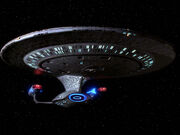
The USS Enterprise-D, a Galaxy-class starship
The Galaxy-class was a Starfleet vessel first introduced in the 2360s. It was the largest and one of the most powerful Federation starship classes of its time. As such, many saw action in the Dominion War.
The Galaxy-class began development in the 2350s at Utopia Planitia Fleet Yards. Numerous technologies implemented on Galaxy-class starships were tested aboard earlier prototype vessels, including the Oberth-class USS Pegasus, in the 2350s. The warp core was designed at Outpost Seran-T-one on stardate 40052 by some of the most brilliant engineering minds in the Federation, including Leah Brahms of the Theoretical Propulsion Group.
The most famous Galaxy-class ship was the USS Enterprise-D, under the command of Captain Jean-Luc Picard. The ship made many official first contacts with a multitude of new species, including the Borg Collective, the Ferengi Alliance, and the Q Continuum.

Enterprise, NX-01
One of the most important starships in interstellar history, Enterprise (NX-01) was the culmination of the NX Project. The NX-01 was the first NX-class starship, launched by the United Earth Starfleet in 2151. Enterprise established United Earth as a legitimate interstellar power and caused a wholesale revolution in Alpha and Beta Quadrant politics, paving the way for the creation of the Coalition of Planets in 2155, and eventually the United Federation of Planets in 2161.
Enterprise was launched from the Orbital Drydock Facility on April 12, 2151, under the command of Captain Jonathan Archer. The launch occurred three weeks ahead of schedule, because of the need for United Earth to return Klaang, a Klingon, to his homeworld of Qo'noS. The early launch was strongly protested by Vulcan Ambassador Soval, who believed Humanity was not ready to explore space. He did manage to wrangle a concession from Starfleet, forcing Archer to allow the placement of Sub-Commander T'Pol, of the Vulcan High Command, on his vessel in exchange for Vulcan star charts.
Once Klaang was returned, Enterprise soon explored an argon-rich planet occupied by slug-like animals. Not long afterwards, the crew descended on and explored their first class M planet, eventually named Archer IV. The crew also made first first contact with a pre-warp civilization shortly afterwards.
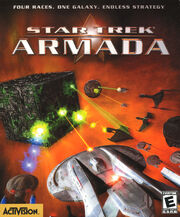
Cover of Star Trek: Armada
Star Trek: Armada is a real-time strategy (RTS) game published by Activision in 2000. The game can be played either as a single-player campaign, or in a multi-player internet combat mode. In either mode, the player(s) build and maintain fleets and stations of one of four races: Federation, Klingon, Romulan, and Borg. The single-player mode is story-driven: the player has a series of objectives to complete twenty missions, in an interwoven storyline covering all four races.
One main complaint about Armada was that each race could only build six types of starships and two construction/collection ships, and that each race's ships were essentially the same ship with different sprites thus giving no race an advantage over the other. Fans dealt with these problems by creating a series of game modifications, or "mods" that ranged from cosmetic changes, to completely new games using the Star Trek: Armada engine.

A Hirogen hunter
The Hirogen were a nomadic species of hunters who were encountered by the USS Voyager in the Delta Quadrant. They viewed other lifeforms as prey and treated them as such, showing little evidence of morality.
Hirogen adult males were quite large, standing above the average height of other known humanoid species. They also possessed greater physical strength than most humanoids afforded to them by their advanced muscle and nervous system. Their sensory perception was acute, a feature that served well as the Hirogen were an aggressive hunting species. The Hirogen also possessed an impressive immune system and used an enzyme to break down the bones and muscle tissue of their prey, suggesting that the Hirogen used some of their victims as food. The color of Hirogen blood was red.
Little is known about Hirogen women, though it has been suggested that they pursued male hunters in possession of rare or unique trophies acquired during a hunt.
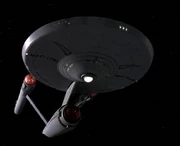
The USS Enterprise on the viewscreen of the Defiant
"Trials and Tribble-ations" is the sixth episode of the fifth season of Star Trek: Deep Space Nine, and was created as a tribute to The Original Series for Star Trek's 30th anniversary.
Lucsly and Dulmur from Temporal Investigations arrive on DS9 to ask Sisko about a recent temporal incursion in which the USS Defiant went back in time. He tells them the full story may take some time – no pun intended – and begins to recount the events leading to the incursion.
The Cardassian government had expressed a desire to return one of the Bajoran Orbs, so the Defiant went to Cardassia Prime to retrieve it. Before leaving Cardassia Prime, Barry Waddle, an elderly, seemingly harmless, Human merchant who had been trapped on Cardassia when the Klingons attacked, also came aboard.
Halfway back to DS9, Chief O'Brien announces a massive surge in chroniton radiation around the ship as the entire bridge glows brightly and the viewscreen shows nothing but white noise. The ship drops out of warp and decloaks as someone activates the transporter. Sisko orders Lieutenant Commander Dax to get the ship back under cloak as O'Brien repairs the viewscreen. When the image is restored the crew is shocked to see the original USS Enterprise – James T. Kirk's ship – in orbit of Deep Space Station K-7...
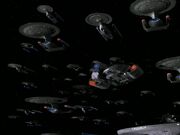
The Federation fleet advances on the Dominion
Operation Return was the combined Starfleet and Klingon Defense Force assault against the Jem'Hadar and Cardassian military forces in the Bajoran sector, launched in mid-2374. The objective of the mission was the recapture of starbase Deep Space 9, which had been captured by the Dominion in the opening battle of the war approximately five months previously. It is considered one of the more pivotal battles of the Dominion War.
In the opening months of the war the Federation suffered an almost unbroken series of defeats at the hands of the Jem'Hadar, and showed little capability of stopping and turning back the Dominion's all-out offensive. In addition, Starfleet's few attempts to mount counteroffensives, such as the Seventh Fleet's attack on the Tyra system, were met with overwhelming losses. Out of the 112 ships in the Seventh Fleet, only 14 survived the fight at Tyra and made it back to Federation lines. The Federation and her Klingon allies were unquestionably losing the war.

